
Founded even before our era, the city of Bologna, a significant round of development of which took place in the Middle Ages, preserves a rich history and a restored historical center, the project of which was carried out until the end of the 19th century, when Bologna was one of the few remaining large fortified cities in Europe.
To this day, despite extensive bombing in 1944, Bologna's historic centre, an area 141,64 hectares, is the second largest in Europe, holds an important medieval monuments, Renaissance and Baroque.
Once the city was surrounded by a defensive wall with 12 gates, most of which have survived to this day. These gates are currently framed in the historical centre of Bologna.
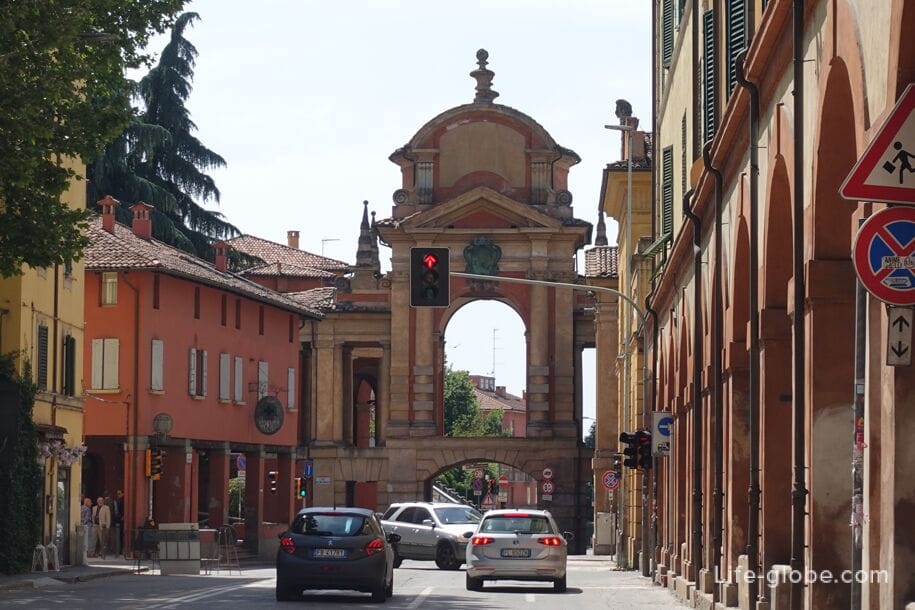
Old town of Bologna, vivid and lively, for the most part with narrow streets, along which numerous tourist attractions, including monuments of history and architecture, archaeological sites and towers, churches and basilicas, palaces and squares, museums and theaters.
Bologna's historic centre is the main focal point of tourist life. Here, in addition to sights, concentrated shops and souvenir shops, cafes and restaurants, a shopping center and markets, as well as hotels, guesthouses, apartments and other accommodation facilities
Moreover, Bologna's historic centre is quite compact, it is easy to get around on foot, which gives an additional advantage when exploring the main attractions of the city.
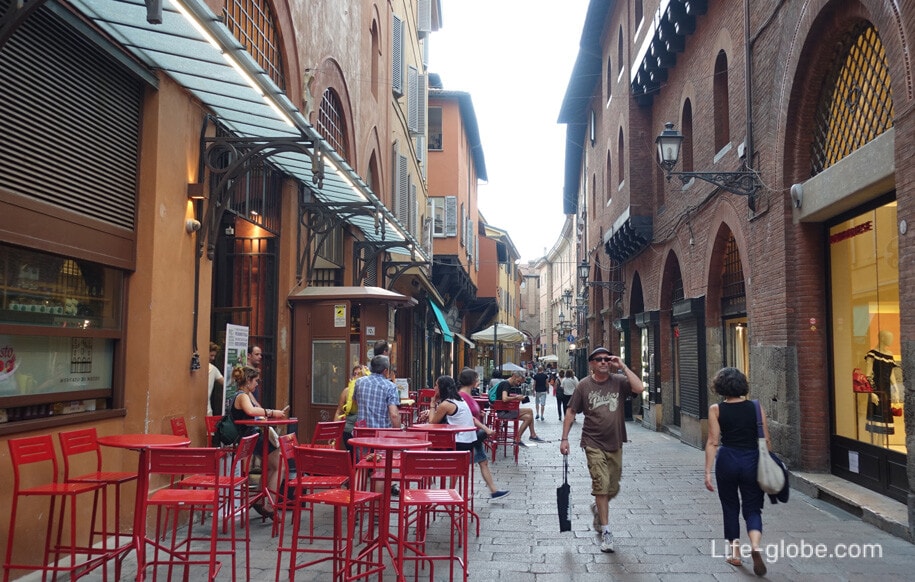
One of the monumental and the most recognizable attraction of Bologna is the Bologna University (Universita di Bologna), founded in 1088 and considered the oldest University in the world. For this reason, Bologna is also known as the city of universities.
In the middle ages the city was an important centre of European intellectual life, attracting scholars from Italy and many parts of Europe.
Previously the location of the University was scattered throughout the city, and to support students of a certain nationality were created by the various colleges.
During the Napoleonic era, the headquarters of the University was moved to its present location on via Zamboni, 33 (Via Zamboni, 33). Today the University has 11 schools, 33 faculty and 93 libraries distributed throughout the city, also includes four subsidiary campuses in nearby cities: Cesena, forlì, Ravenna and Rimini.
Among the graduates of the University of Bologna may be noted such outstanding individuals as Dante, Petrarch, Pope Nicholas V and Copernicus. Laura Bassi, appointed in 1732, became the first woman to officially teach at a European College.
In one of the former buildings of the University now houses the Anatomical theatre (Teatro Anatomico), which once served as a showroom for medical students.
The first anatomical theatre was built in 1595 and was located in a different place, but it was replaced by a larger built in 1636 - 1638 years in present location.
During its history the theatre has undergone several modifications and reached its final form between 1733 and 1736 and the. In this period, Silvestro giannotti of carved wooden statues that adorn the walls of the theatre and represent some famous physicians of ancient times (Hippocrates, Galen, etc.) and local doctors (Andinus, Gaspare, Tagliacozzi - keep his nose in his hand, because he was the first who tried to do plastic surgery).
The theatre was almost completely destroyed during the Second world war air RAID on 29 January 1944. After the war, the theatre was rebuilt using original parts found among the rubble of the building.
In the center of the theatre is a white table on which was the dissection of the human body or animal.
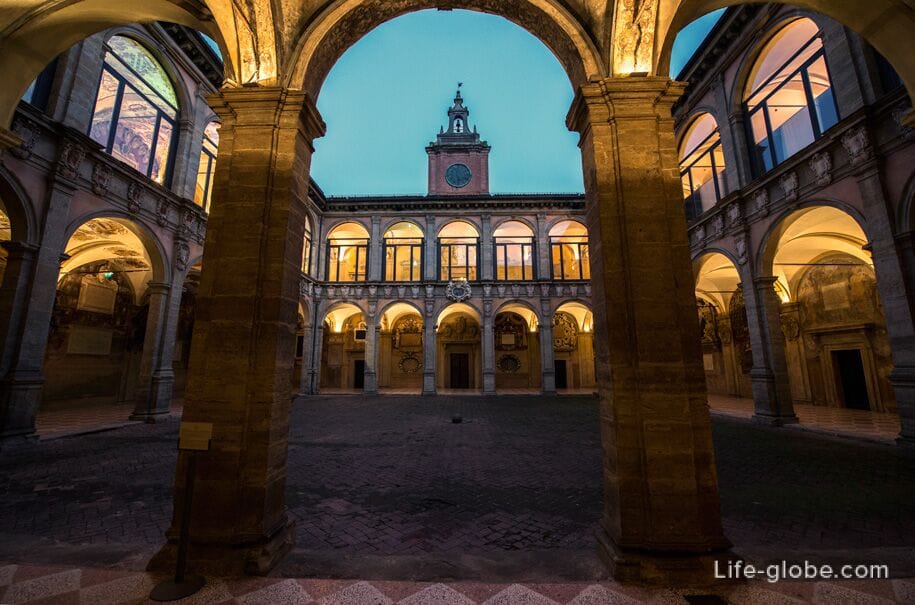
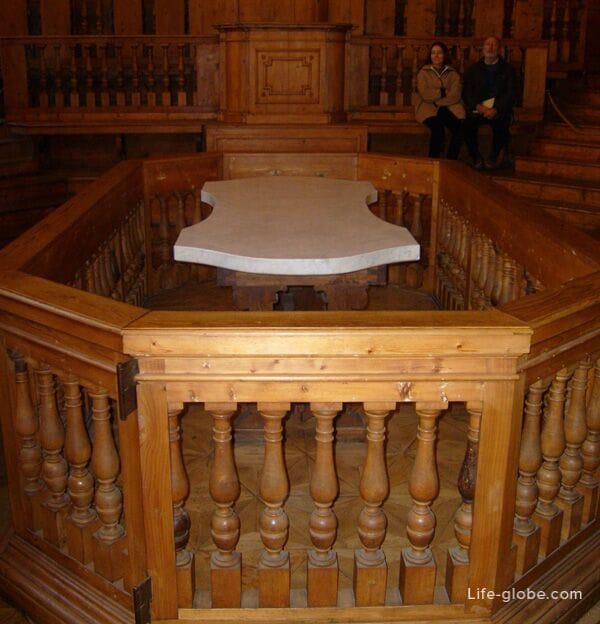
The heart of Bologna's historic centre stands the Piazza Maggiore (Piazza Maggiore) is the largest and most Central square of the city, the history of which originates from the 13th century, when the municipality started to purchase the house and adjacent land for the construction of the square, which would become an important element and gathered all kinds of urban activities (manufacturing and various services) at the same time.
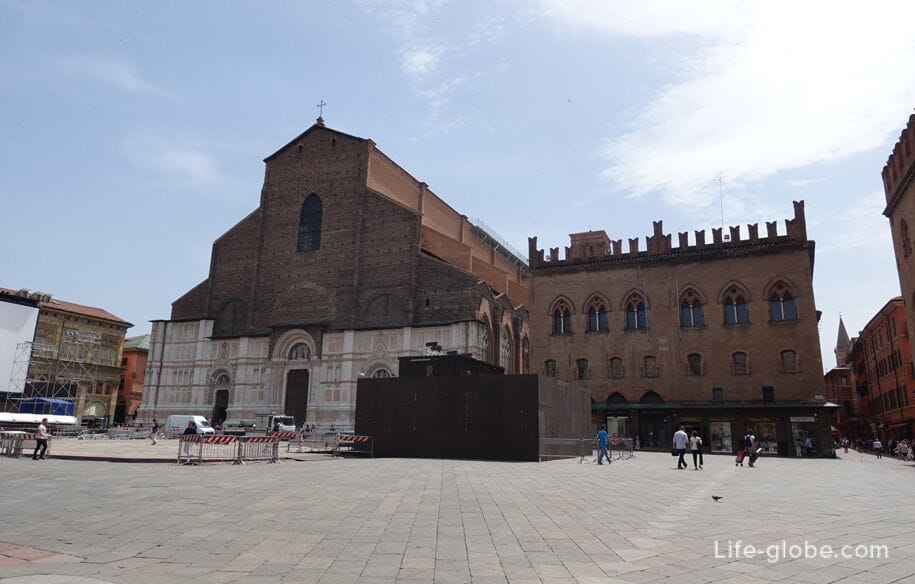
The perimeter of Piazza Maggiore decorate the main administrative and religious buildings of Bologna:
- Basilica of San Petronio (Basilica di San Petronio) - Cathedral of Bologna, dedicated to the patron Saint of the city, the Bishop of Bologna in the fifth century, St. Petronius. In the Basilica you can climb to the panoramic terrace, to visit the chapel of the Magi, and the Museum of Saint-Petronius;
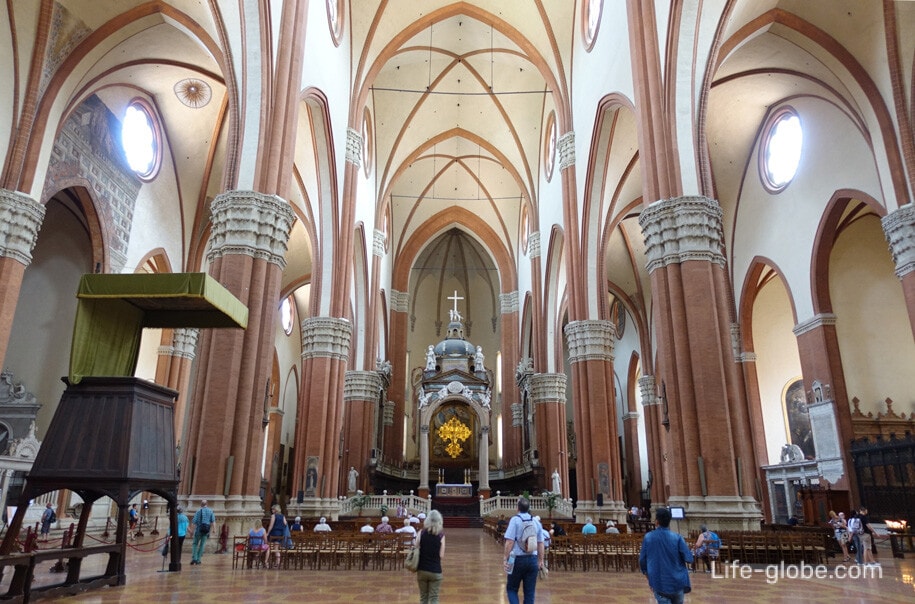
Palazzo del Podesta - first place city government, built in 1200 years, now representing a long building with a large hall on the top floor with a double open arcade on the ground floor, along which are shops and cafes;
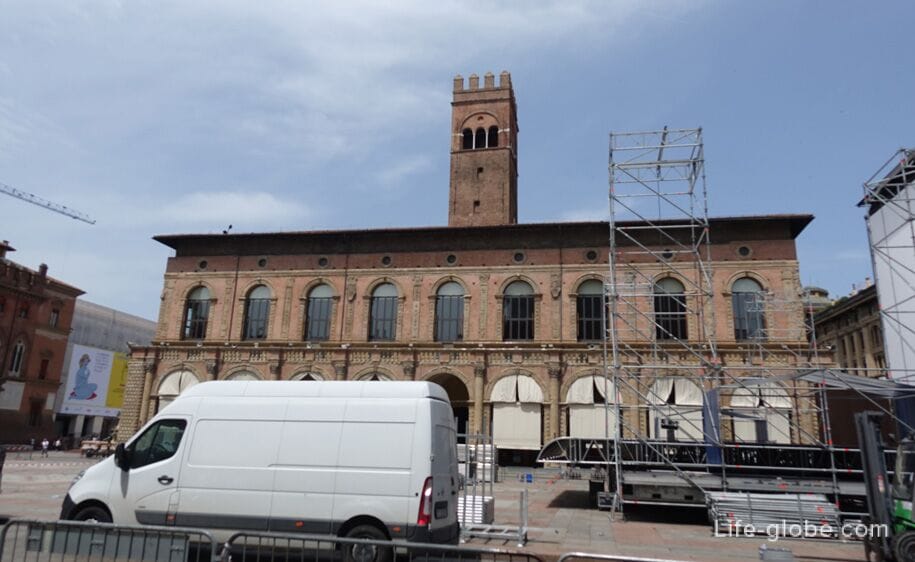
- Palazzo dei Banchi - a former banking center, a Palace designed in the Renaissance style, rising in the second half of the 16th century.
In the Palazzo shops and cafes, offices and private apartments, and behind the Central structure of the Palace are: the municipal archaeological Museum, the Church of Santa Maria della Vita and Mezzo market (Mercato di Mezzo);
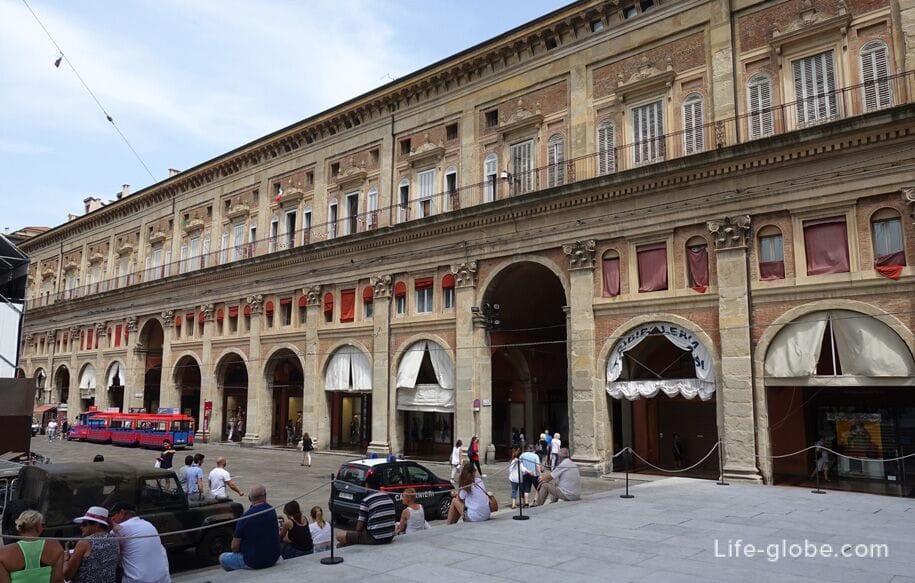
- Palazzo d'accursio or Comunale / Palace of the Commune (Palazzo d Accursio / Palazzo Comunale), former city hall, now the art Museum is the most magnificent and externally conspicuous building in the Piazza Maggiore. Read more about Piazza Maggiore in Bologna...
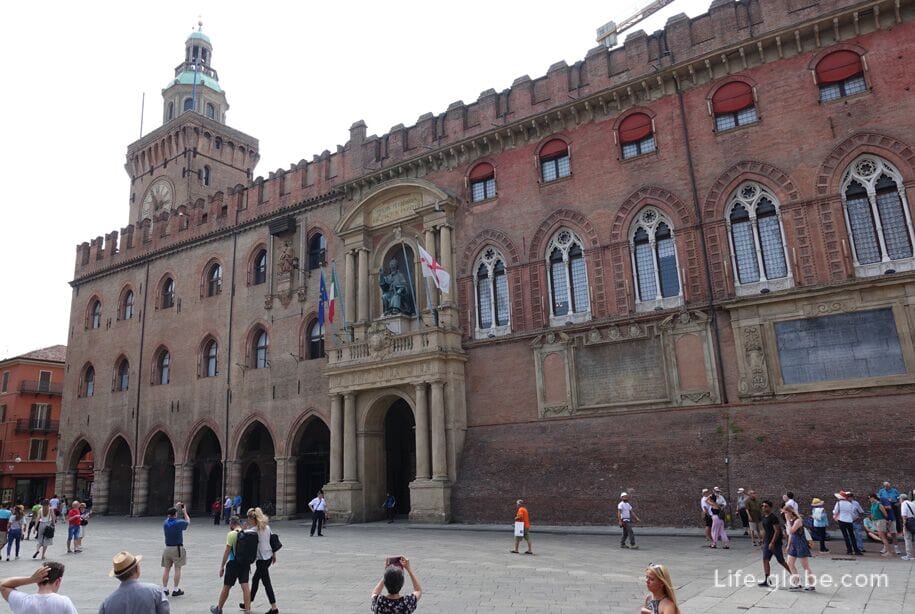
To the North-West side of the Piazza Maggiore is adjacent to another attractive area, founded in 1565 - Neptune square (Piazza del Nettuno), which is decorated with the famous monumental Fontana del Nettuno or fountain of Neptune (Fontana del Nettuno) on two of the sides are important historical buildings: the library of Salaborsa and Palazzo Re Enzo.
Together, Piazza Maggiore and Neptune form a large space of the historic center of the city with the architectural ensemble, which includes some of the most important shrines and buildings in the centre of Bologna. Read more about square Neptune in Bologna...

From Santa Maggiore and Neptune, diverge in different directions, many streets of the historic part of the city, which is a main tourist routes in Bologna. These streets are littered with the abundance of shops, cafes and restaurants.
Along many of the streets are drawn porticos, which is a great shelter from direct sunlight during hot summer days. In total, the historical centre of Bologna, there are about 38 kilometers of porticos and more than 45 km in the city.
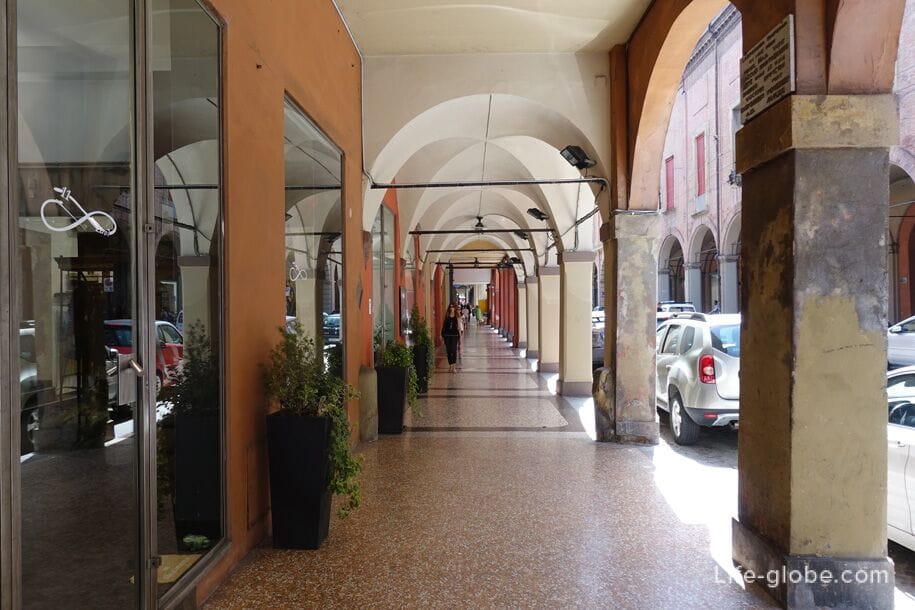
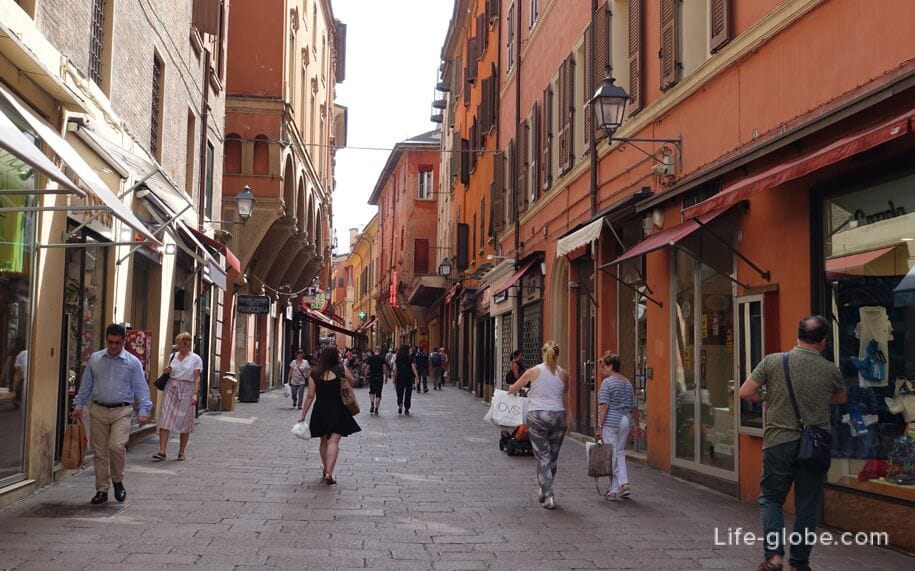
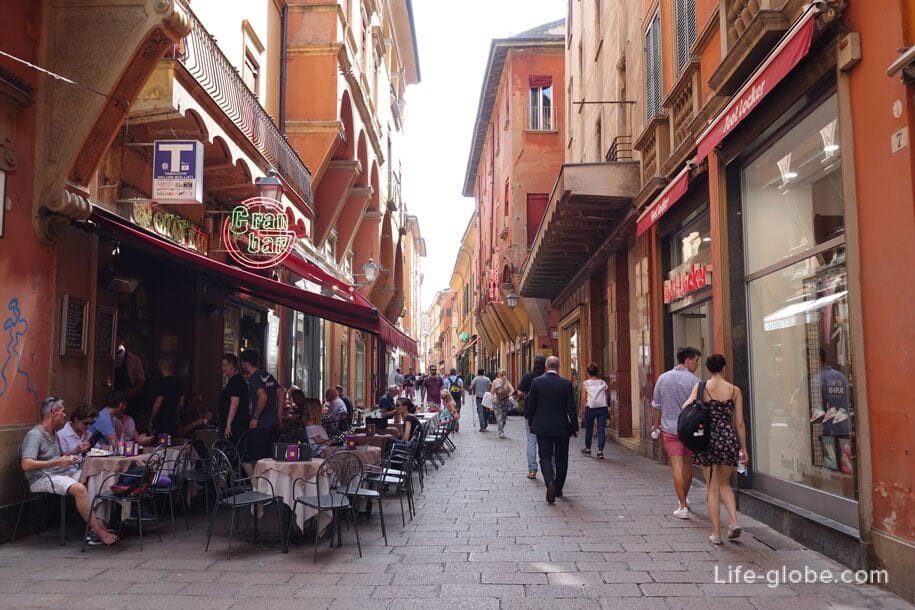
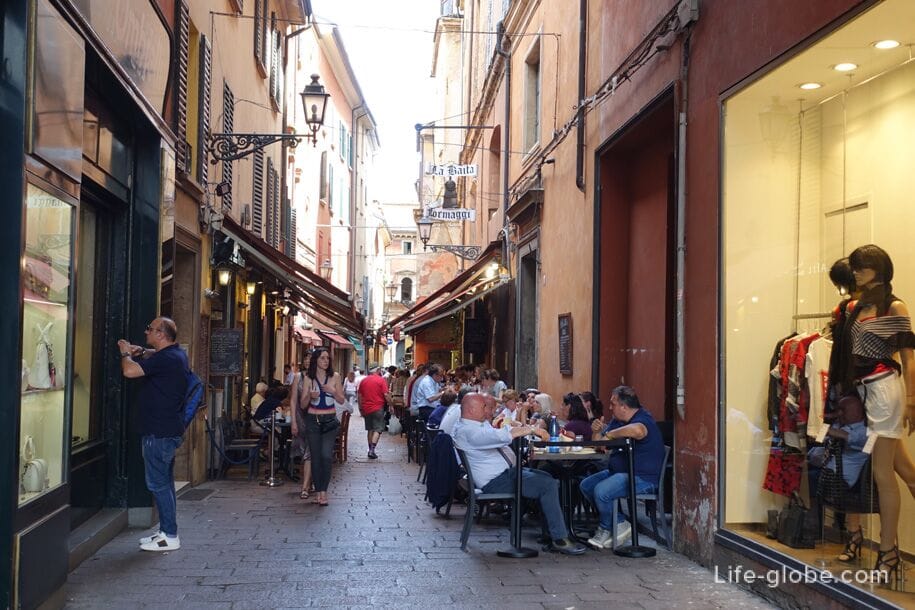
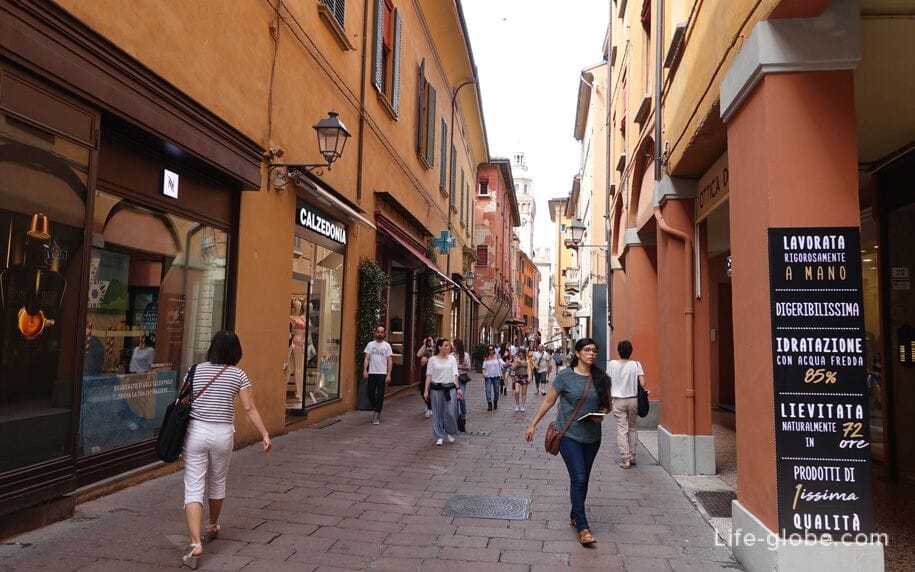

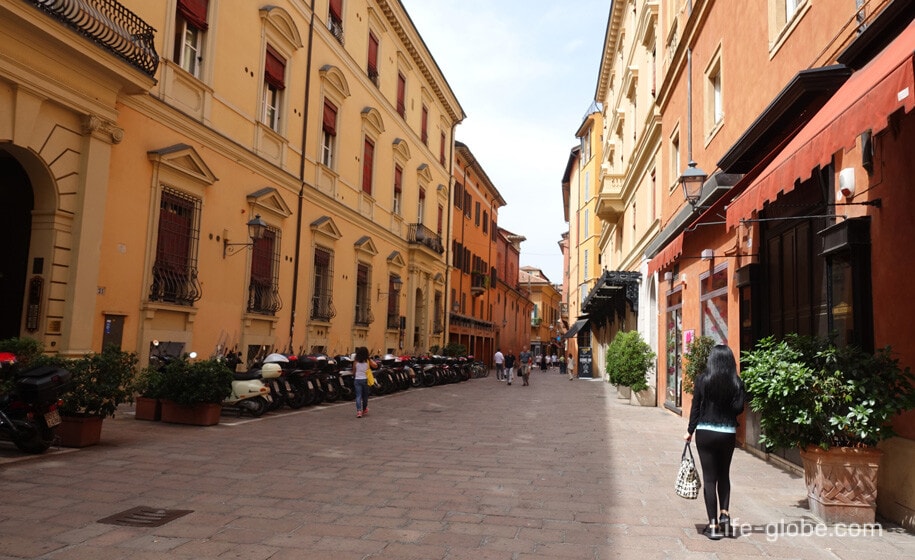
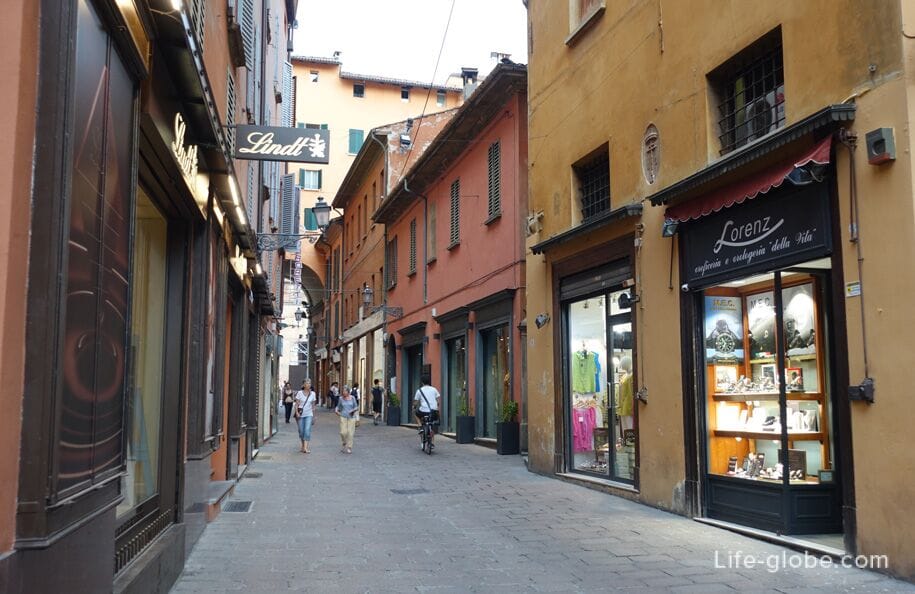

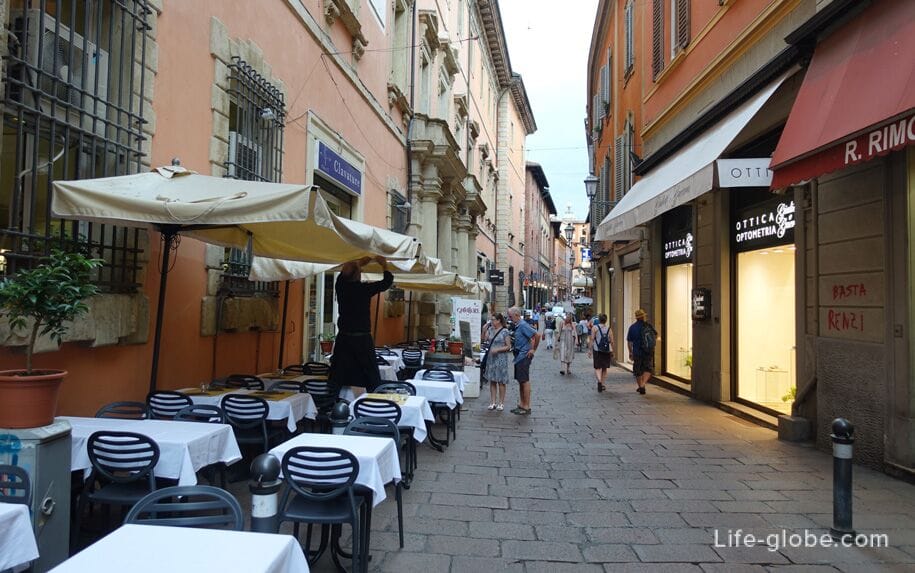
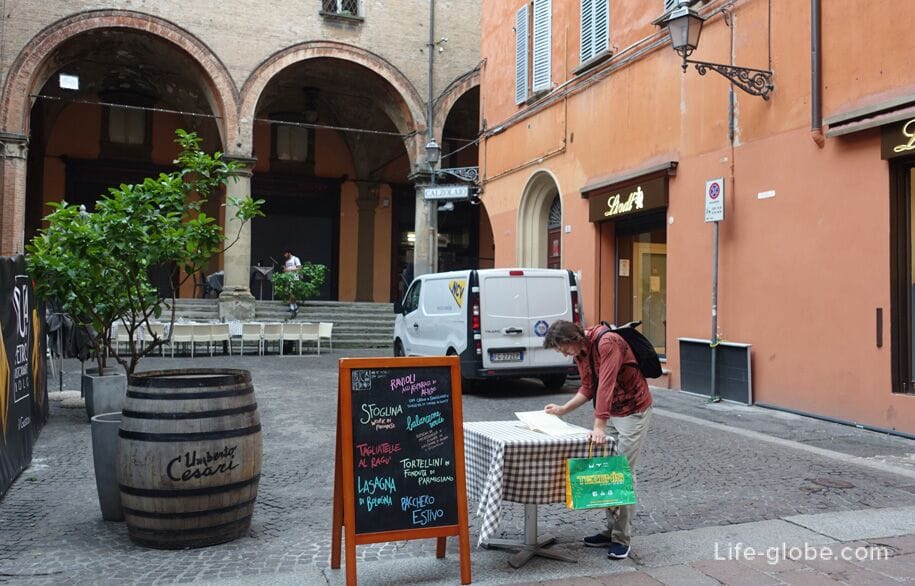
Street 4 Nov (Via IV Novembre) notable sculptures "social sculptors" Nicola Zamboni and Sara Bolzani, considered among the original among his contemporaries in Italy.
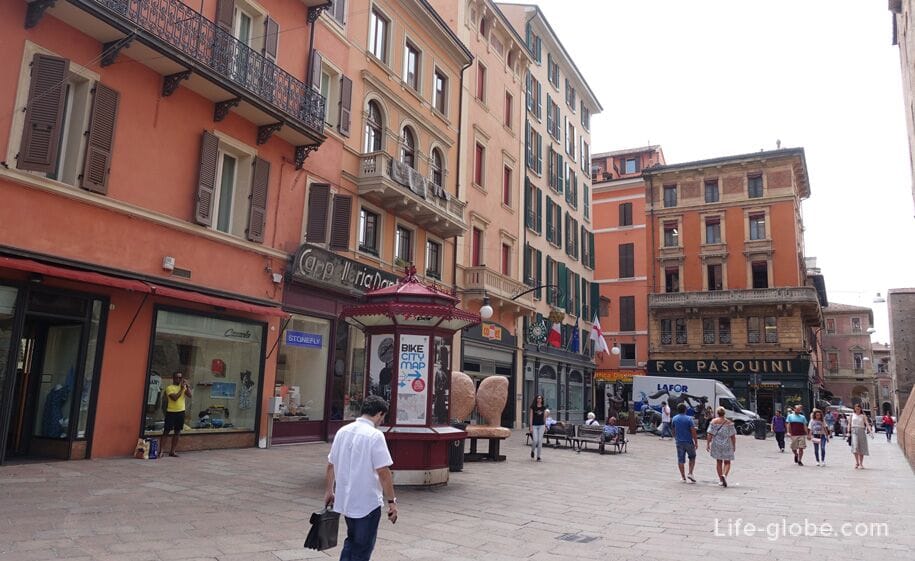
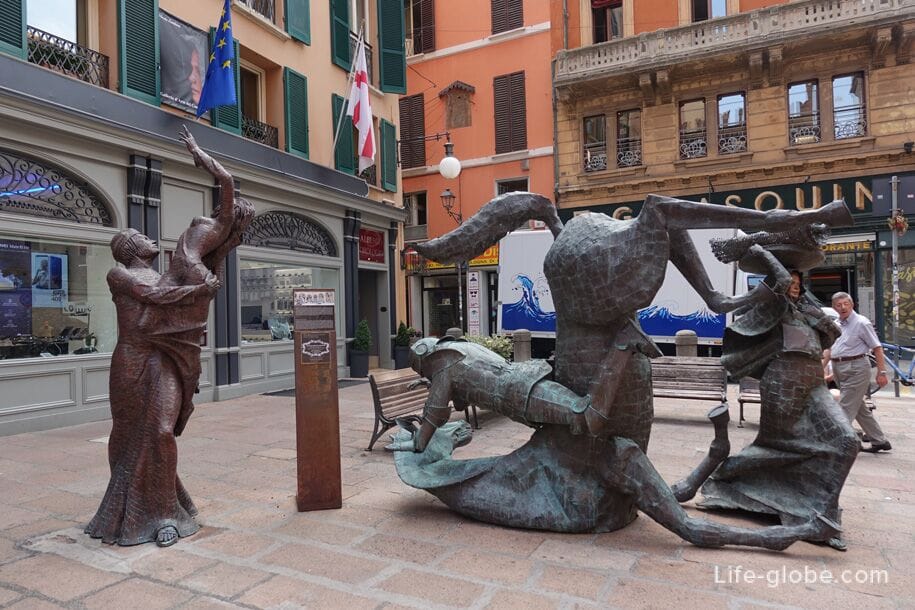

Near Piazza Maggiore, Galleria Cavour - the famous shopping center of Bologna.
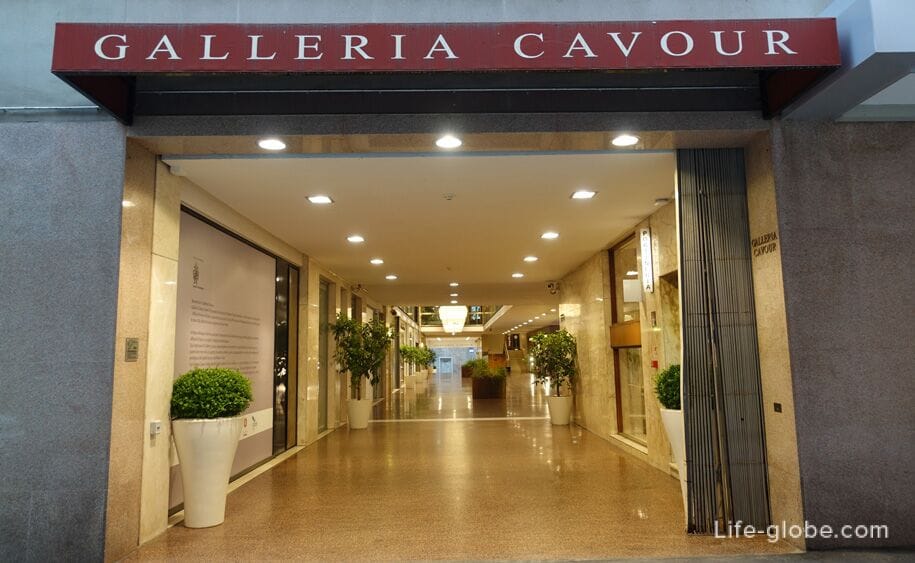
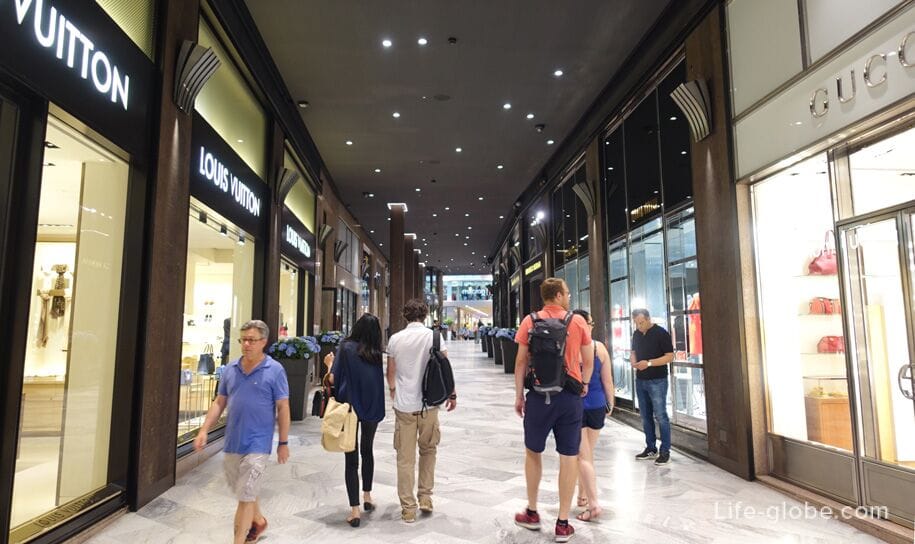
Near Neptune square is the Cathedral Basilica of Saint Peter or San Pietro (Cattedrale di San Pietro).
Much of the current Church building dates back to the 17th century, and some parts - by the end of the 16th. The new facade was added between 1743 and 1747 years.
The interior of the Cathedral, executed in the Baroque style, from the first minute visit creates an impression of grandeur.
Among the most famous works of art of the Cathedral it is possible to allocate some of the preserved frescoes, the Crucifix of cedar wood, and a sculpture group depicting "the Lamentation over the Dead Christ" (the work of Alfonso Lombardi, the beginning of the 16th century).
Also noteworthy: the Cathedral's bell tower which you can climb and the Cathedral Museum, which displays religious items, utensils, furniture and liturgical vestments, Dating from the fifteenth to the twentieth centuries. Read more about Cathedral of Bologna...
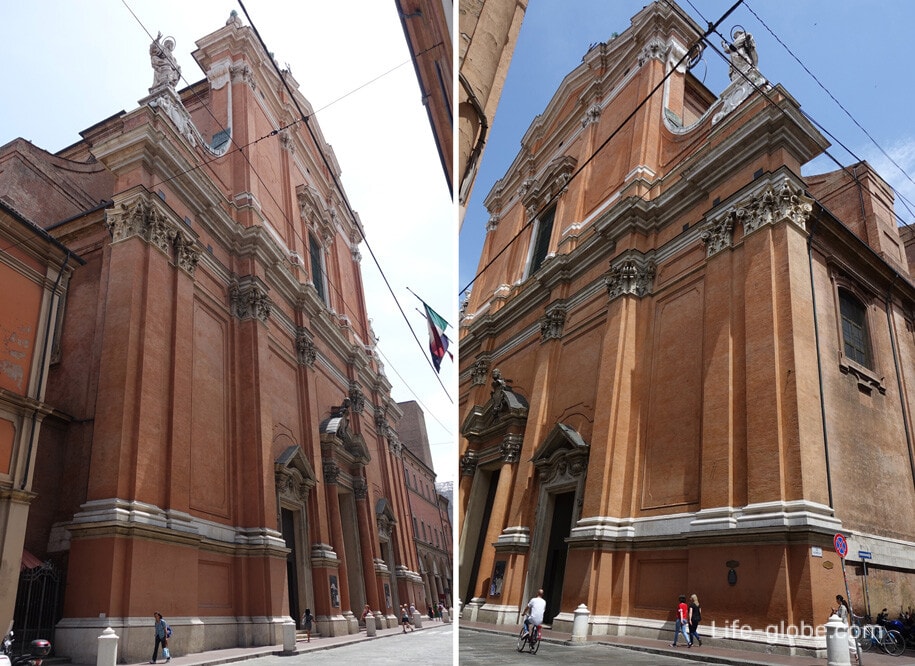
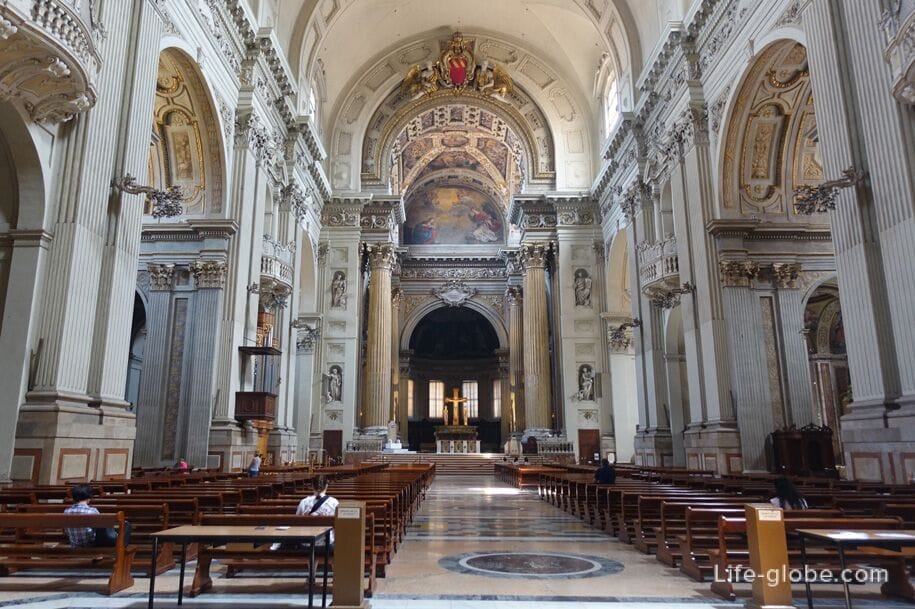
Areas close to Maggiore and Neptune square Port Ravagnan (Piazza di Porta Ravegnana), the famous towering towers Bologna - Asinelli and Garisenda (Le due Torri Asinelli, Garisenda), known as the Two towers or "Leaning tower".
Built of masonry, towers fulfilled an important military function and was represented by its grandeur the social prestige of noble families.
High tower tower of the Asinelli, known today as the highest of all the "Falling towers" of Italy. The tower is accessed via internal wooden staircase. The tower offers panoramic views of the historical centre of Bologna. And under the arcade of the tower there are retail outlets, reminiscent of the medieval trade function "Mercato di Mezzo".
The Garisenda tower is a smaller tower or a small tower, but more falling - has a greater slope. Read more about the two towers of Bologna...
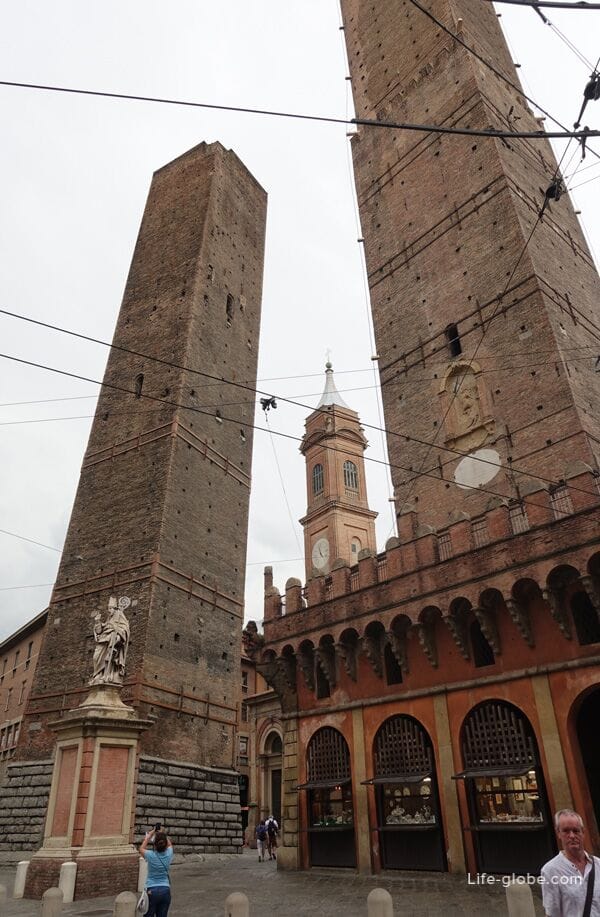
Not so long ago the statue of San Petronio, created by Gabriele Brunelli in 1670 was installed in front of the towers.
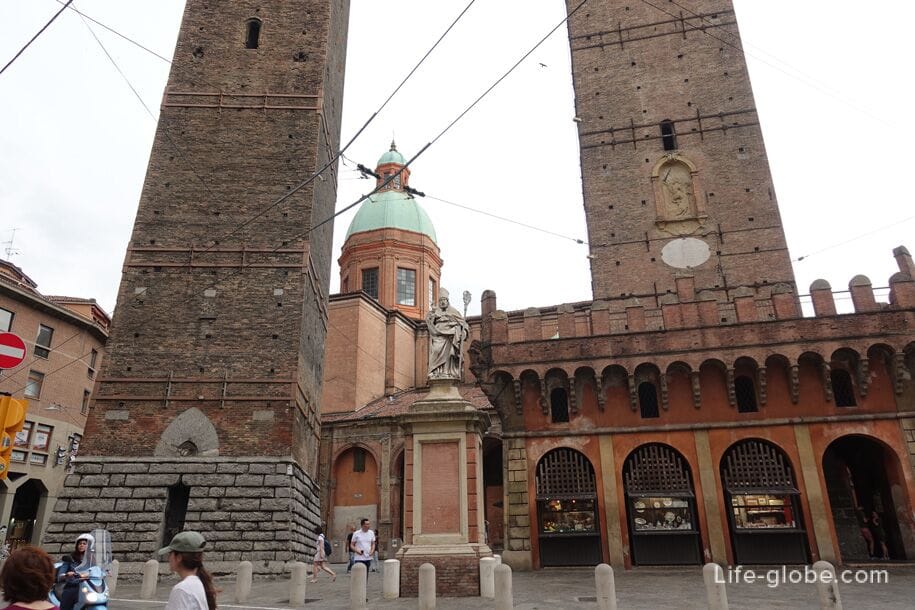
For towers located the Church of San Bartolomeo (Chiesa Santi Bartolomeo e Gaetano). The Church originally belonged to the order of St. Benedict, after a group of nuns in the 13th century, in 1516, was demolished to replace it with a large building designed by Andrea da Formigine, who built the portico and enriched in fine jewelry (now damaged).
At the end of the 16th century the Church was transferred to Tatincom, after which the original building was added a new tower and the dome, and then was renamed the Church itself received its present name of San Bartolomeo.
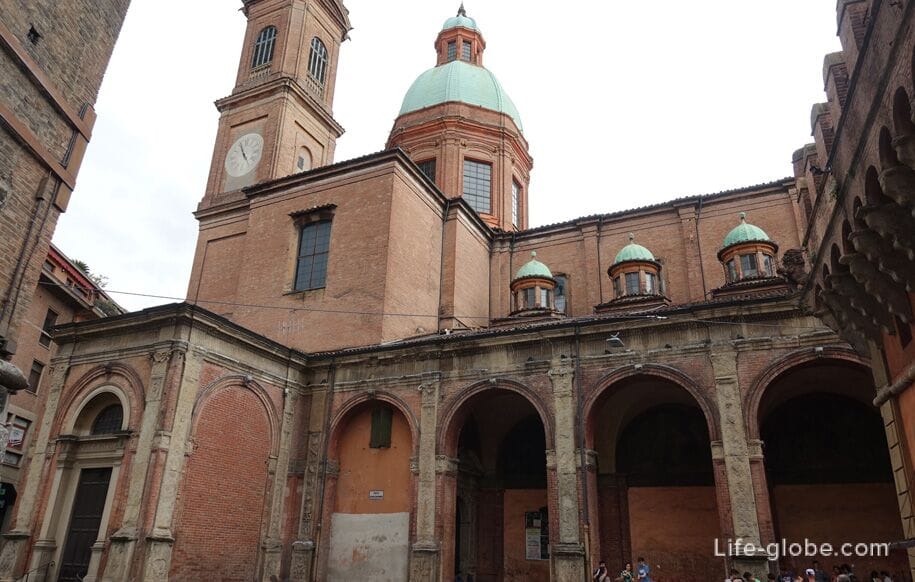
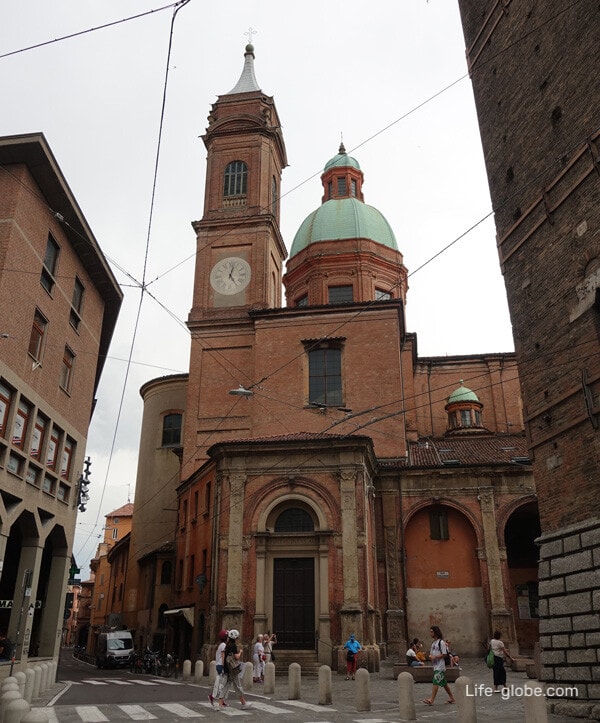
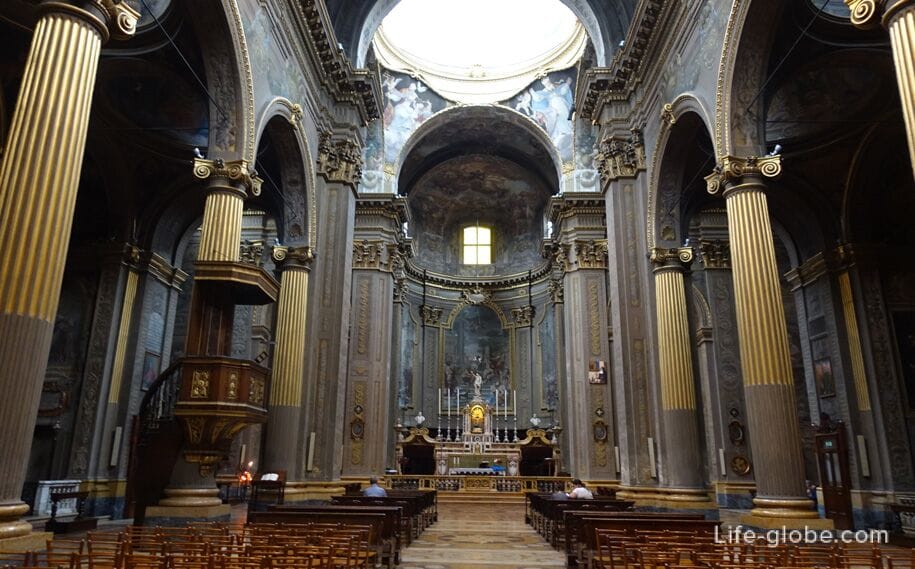
Palazzo della Mercanzia or the Palace of Trade / Merchants (Palazzo della Mercanzia), where the Trade-industrial, agricultural and craft chamber, with the end of the fourteenth century governing commercial and trading activities of Bologna.
In 1384 under the direction of Antonio di Vincenzo and Lorenzo da Beniamino began construction of the loggia Carrobbio (current Mercanzia) to merge the three houses used for customs. Construction was completed in 1391. In posleduyushim there have been several extensions and restorations as well as recovery.
The facade, built of brick and stone, has two large Gothic arches. Above the arches, between two arched Windows, stands a small marble balcony, from which the judge read out the sentences. Above the balcony is the elegant spire adorning the top of the building.
Guilty in bankruptcy was chained to a stake in front of the Central column of the building and they were exposed to public ridicule.
The room and the outpatient clinic building despite changes over time, maintain the richness of the artwork.
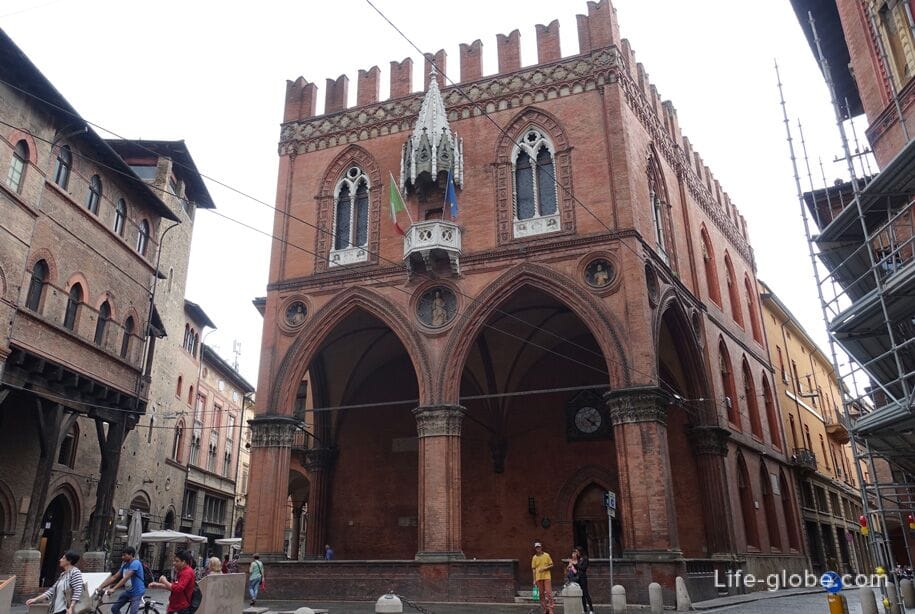
Next to Palace Mercanzia are other important buildings, together representing General stylistic eclecticism, characterized by the coexistence of Roman-Lombard style.
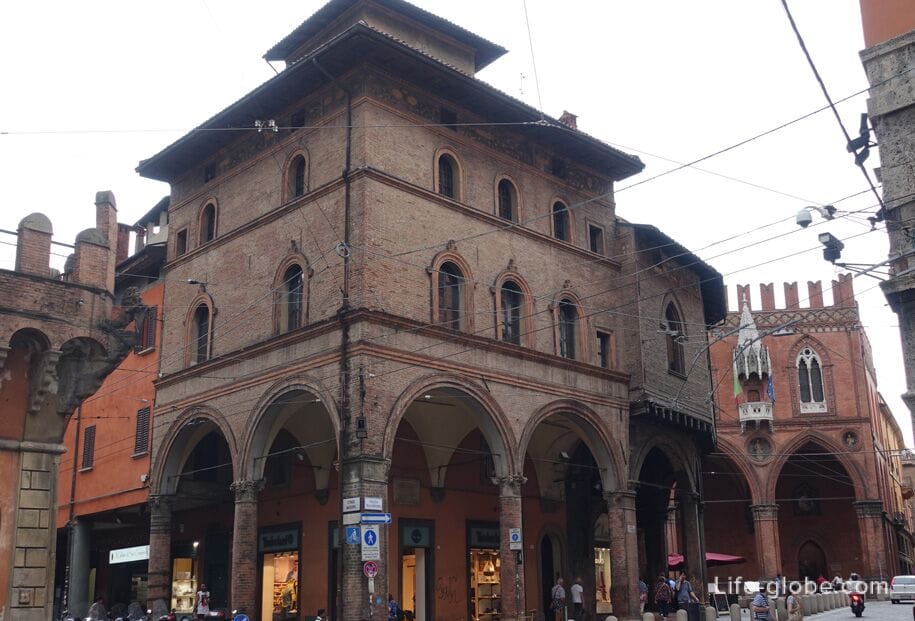
Isolani house (Casa Isolani) is one of the rare examples of houses of the 13th century. The house is characterized by the presence of the portico (arcades), supported by large oak beams (9 meters), which relies on the third floor. During restorations of the 20th century the facade was restored monolithic Windows and arches.

Palazzo Pepoli (Pepoli Palazzo Vecchio), a medieval Palace built in the Gothic style, the walls of which currently houses the Museum of history of Bologna, dedicated to the history, culture and transformations of Bologna.
The land for the Palace was acquired in 1276 aristocrat Romeo Pepoli. In 1344 by Taddeo Pepoli, son Romeo, started the construction of the Palace. The Pepoli family owned the Palace until 1910. After the death of Agostino Siero Pepoli, the Palace was transferred to the municipality.
In 2004 the Fondazione Carisbo bought the Palace and started to create the present Museum of the history of Bologna (Museo della Storia di Bologna).

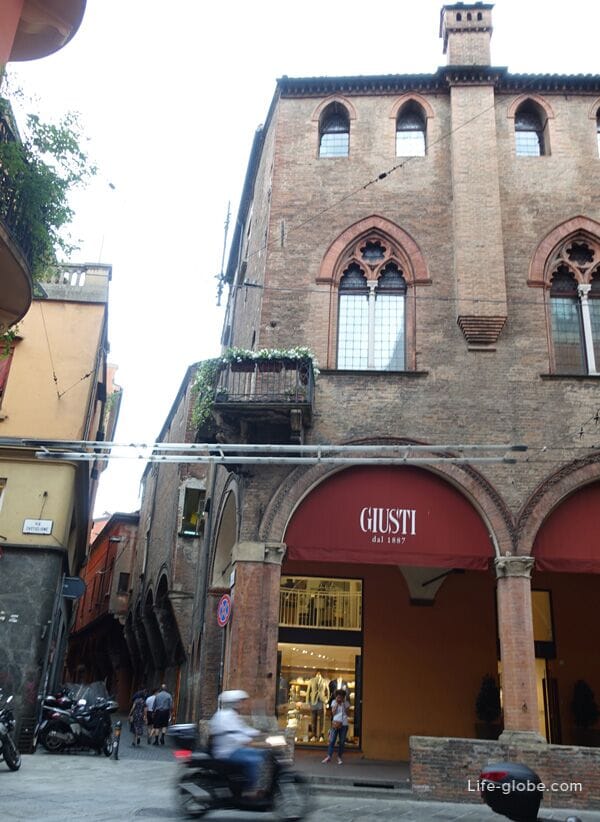
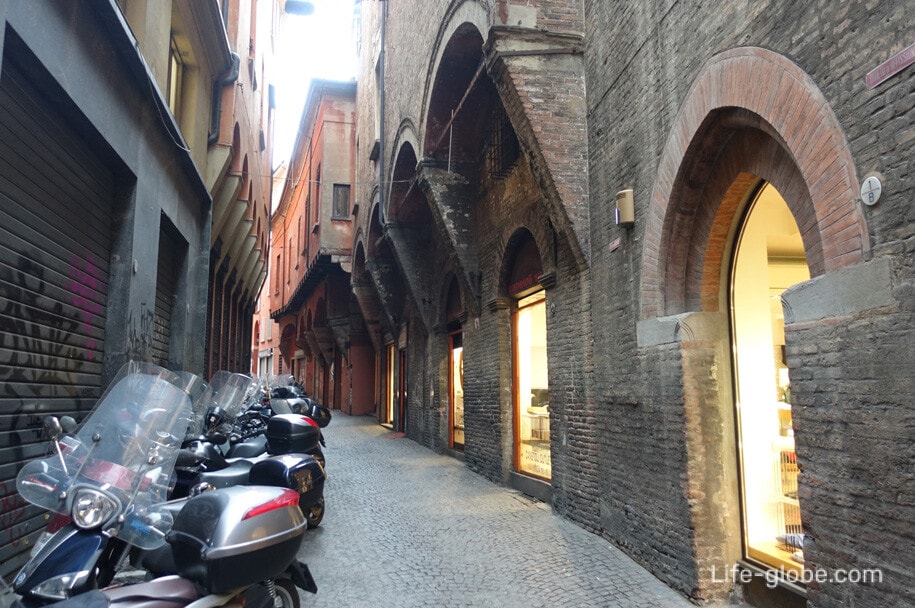
Across the street from Palace Pepoli is a Museum of Palazzo Pepoli Campogrande, also known as the Nuovo Palazzo Pepoli (Pepoli Palazzo Nuovo). Baroque Palace serves as a public art gallery art of the late Baroque, consisting of several rooms.
The Palace was built in the mid 1600's, by order of count Pepoli Odoardo. In the 20th century the new owner of Edwig Campogrande donated the building to the city for the Museum.
The complex of St. Stephen or the complex of Santo Stefano (Complesso di Santo Stefano Basilica di Santo Stefano) is a complex of religious Christian buildings, perhaps the most unusual and voluminous in Bologna.
In people, the complex of St. Stephen known as Cheese Sette - "Seven churches" (Sette Chiese) and "the Holy Jerusalem" (Santa Gerusalemme).
The origin of the complex is very ancient and is still being discussed. Basilica of St. John the Baptist, called "the Crucifixion", dates back to the 8th century; the Church of the Holy Sepulchre belongs to the fifth century; the Basilica of Saints Vitale and Agricola originated in the 4th century.
Now the complex is a consolidated stylistic uniformity, which makes it the most interesting Romanesque monuments in the city. The complex includes: Basilica, a medieval monastery, the courtyards, the chapel, crypt and Museum of Santo Stefano. Read more about the complex San Stefano in Bologna...
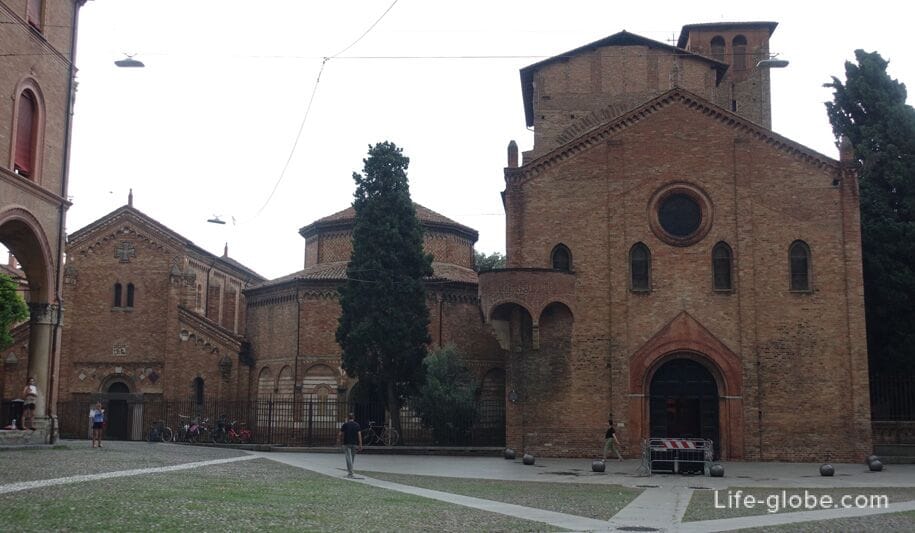

The Roman Catholic Basilica of Santa Maria dei Servi (Basilica di Santa Maria dei Servi) was founded in 1346 as the Church of servitu - the order of the servants of the blessed virgin Mary. In the 20th century, Pope Pius XII assigned the Church the status of Basilica.
The Basilica has the shape of a Latin cross. The Central nave and side aisles separated from each other by round columns with coloured capitals. Plastered walls above the arcade is riddled occult Windows set high under a Gothic arch.
A distinctive feature of the Church is its courtyard or atrium. The area in front of the Basilica was quite small, making it possible to build around it a wide arcade, covering the entire square without interruption. The arcade is closed on one side of the monastic buildings, whereas the other two sides it is open to the street and extends along the entire left side of the Basilica. Where the arcade meets the facade of the Basilica, it forms a "narthex" or wide portico of five arches, stretching across the front of the Church. The arcade has a decorative cornice, and round molding on the sinuses in common with the occult window on the facade.
The Church also is a well-known authority, established in 1967, the company Tamburini of Crema, which can work mechanically.
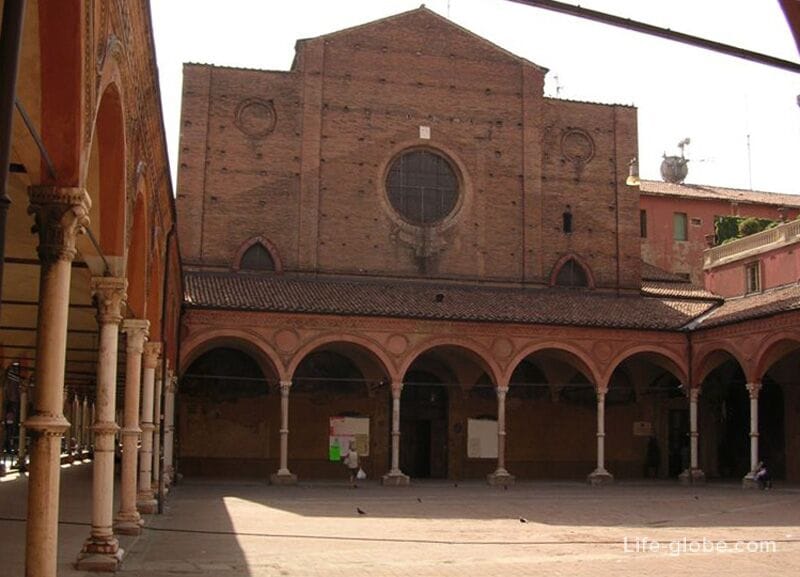
Palazzo Manzoli - Malvasia (Palazzo Manzoli - Malvasia). Palace of the 13th century, belonged to the noble family of Mantle during its history underwent several major reconstructions: first in the sixteenth century, and then in 1760 by the architect Francesco Tadolini. From the original building remained only a few arches.
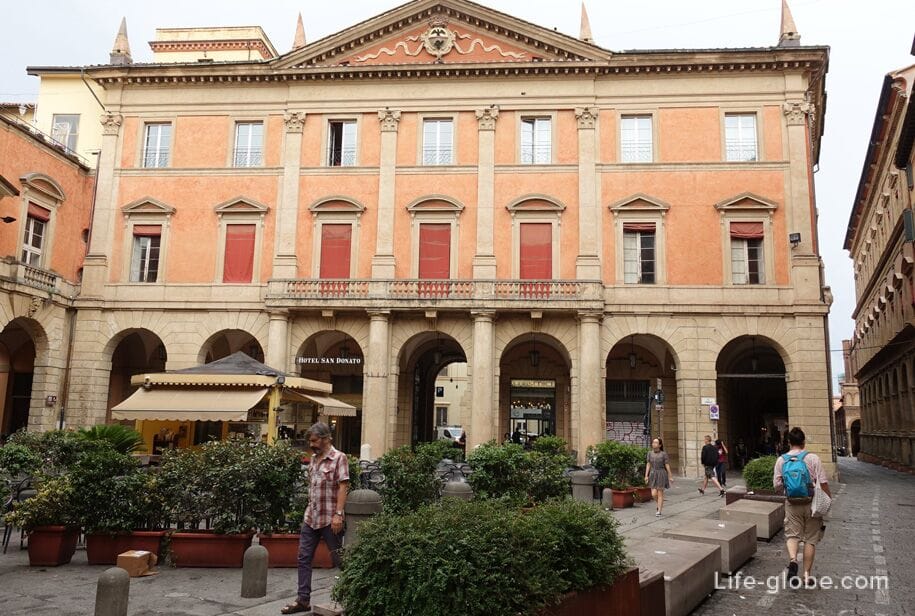
Malvezzi Palazzo (Palazzo Malvezzi de'medici) is a Palace in the Renaissance style, once belonged to the family of Malvezzi, whose construction began in 1560 by the project of Bartolomeo Triazine. Is currently the location of the regional administration.
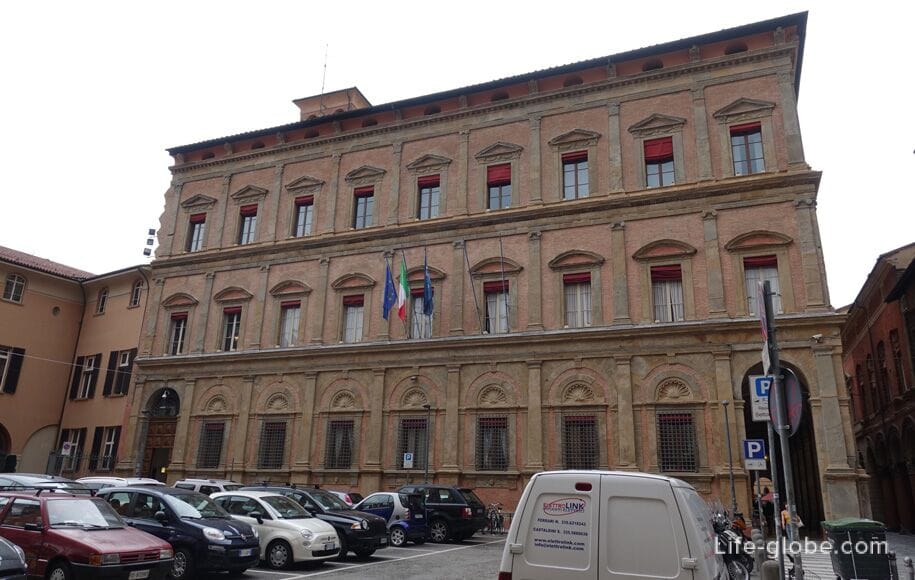
Near the Palace is Malvezzi Palace Malvezzi Campeggi (Palazzo Malvezzi Campeggi) also has a Renaissance style and at one time belonged to the family of Malvazia. The construction of the Palace began in the mid 1500 years over a more ancient construction. Currently, the walls of the Palazzo is the law faculty of the University of Bologna.
Basilica of San Giacomo Maggiore (Basilica of San Giacomo Maggiore) - a historic Roman Catholic Church built between 1267 and 1315 years by the monks of S. Agostino. Restored in the late 15th century.
The facade of the building is the oldest part of the Basilica, with its characteristic late-Romanesque features. Along the left wall of the Basilica is the portico of the Renaissance (1477 – 81 years) which gives access to two cloisters, one 15th and the other 16th centuries. Property is restricted-preserved part of the walls of Bologna the 11th century.
The Church is the dome of the Renaissance, designed by Antonio Morandi. The interior is designed in styles of the Renaissance and Baroque periods, with numerous chapels. In the vaults are frescoes executed in 1495 by the masters, including Lorenzo Costa.
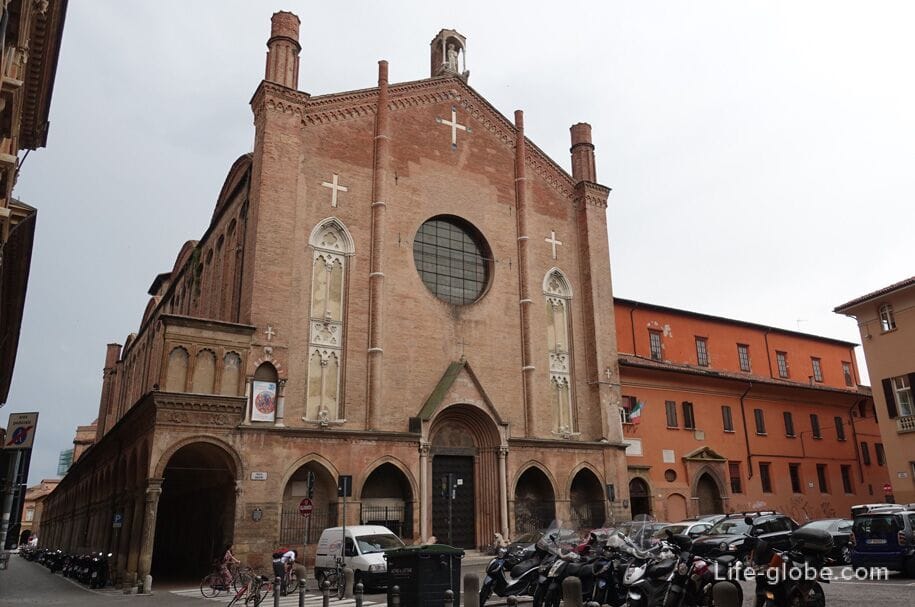
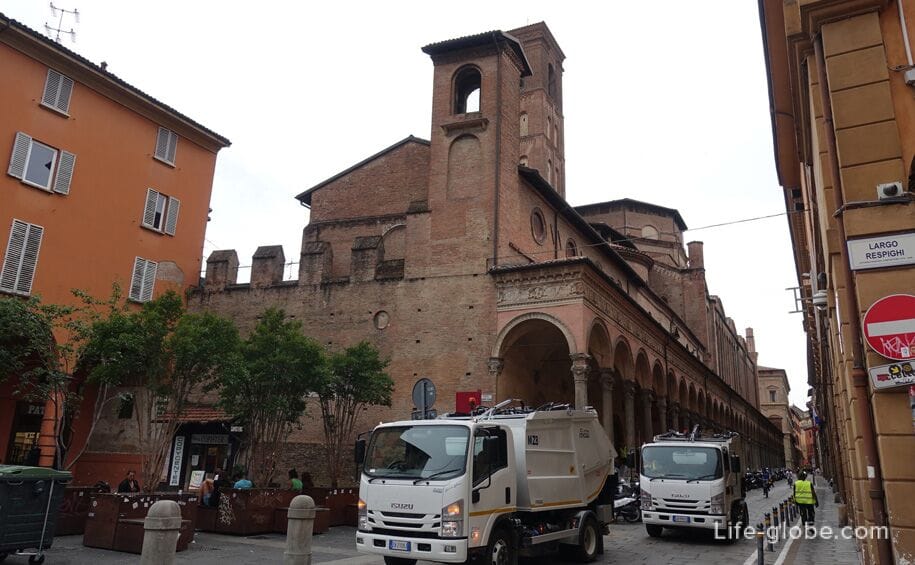

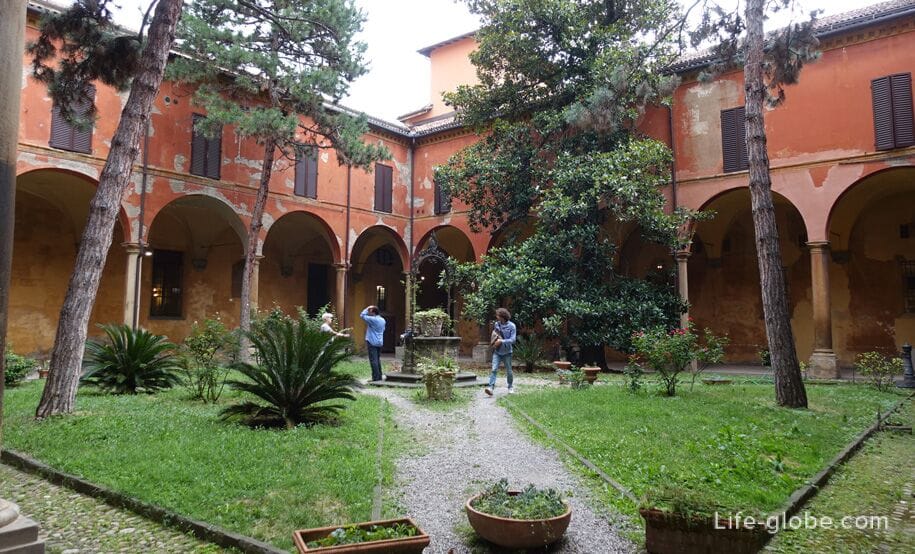
Piazza Giuseppe Verdi (Piazza Giuseppe Verdi), dedicated to the Italian musician Giuseppe Verdi.
In 1951 the square was called Piazza Verdi. On the square stand out some valuable buildings: Palazzo Paleotti (Palazzo Paleotti), which from 1877 to 1890 was placed Aurelio Saffi, an important figure in the struggle for the unification of Italy, now houses a University teaching room and library; the Teatro Comunale / municipal Theatre (Teatro Comunale di Bologna) and one side of the Basilica of San Giacomo Maggiore.
Area, especially in summer, is used for cultural events outdoors.


On the wall of a house in Via D'azeglio, 47, is a small statue of the Devil (Statua del diavolo / Statue of devil).
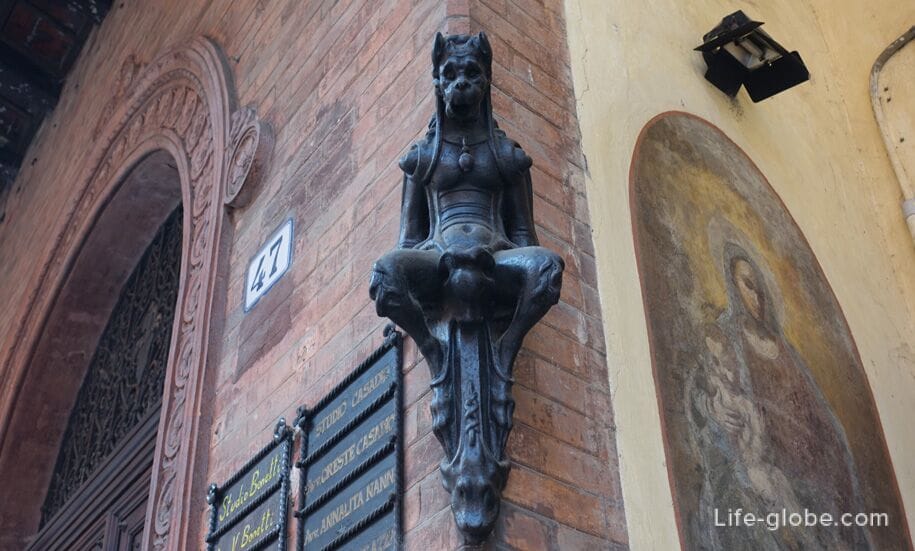
On the same street D'azeglio is the Palazzo Sanuti Bevilacqua Degli Ariosti is a Palace built by count nicolò Canute, between 1477 and 1482 years. Externally, the building is characterized by the absence of the portico, is quite a recurring element in the Bologna palaces of the time.
Inside there is a beautiful courtyard, characterized by two floors of the porticoes (loggias), columns of which are the work of Filippo Tommaso da Varignano.
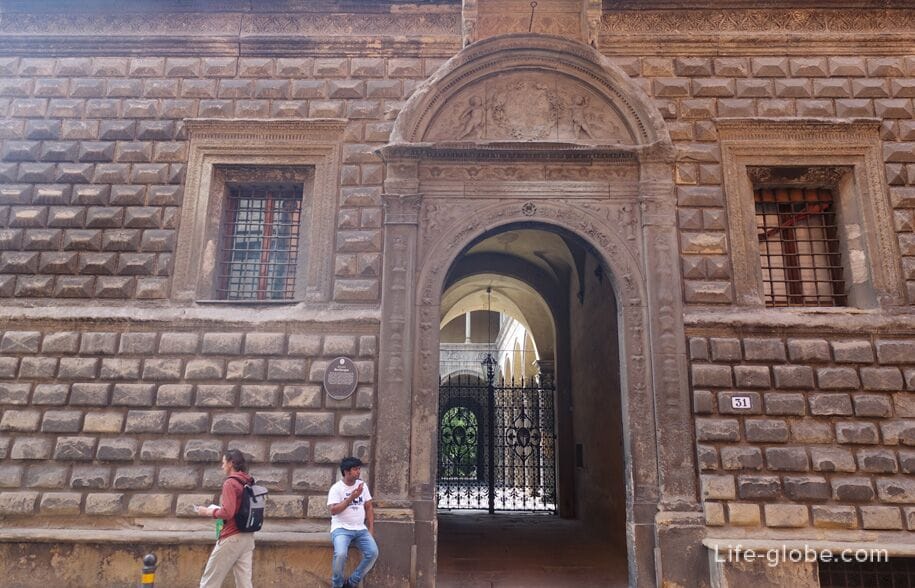
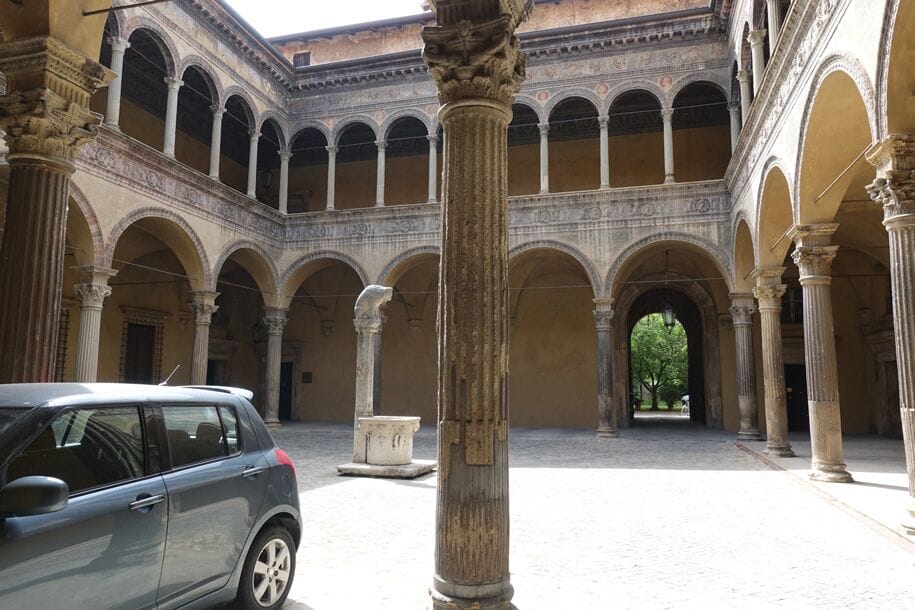
The Church of San Procolo (Chiesa di San Procolo), a very ancient origin, was rebuilt by Benedictine monks in the eleventh century.
During the history the Church underwent intervention such great masters of the sixteenth century as Antonio Morandi (responsible for the repair of the building), Carlo Francesco Dotti (led internal restructuring) and Domenico Tibaldi (expanded apse).
The interior of the Church has three naves with chapels on the sides and behind the altar.
Inside, in the right aisle is the organ, made by Baldassare of Melamine in 1580 and with the additions Gatti (1746 - 1757) and Ferati (1872 and 1883), restored by Franz Seninim in 2007 and 2008.
Buried in the Church of the Bologna artist Paolo Alboni.
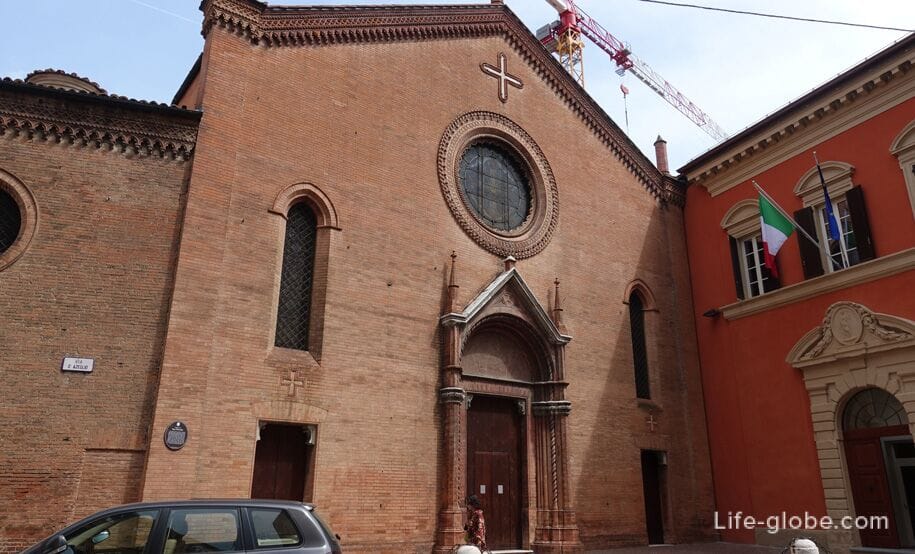
Basilica of San Domenico or of the Holy Domenica (Basilica di San Domenico) is one of the most important churches of Bologna. Dedicated to St. Dominic, the founder of the order of preachers (Dominicans or the Dominican order).
The interior of the Church made in the Baroque style, there are three nave, several side chapels, transept, choir and apse. Also in the Basilica has a small Museum which houses works of art and religious relics, and nearby is the monastery contains the cloisters 14th to 16th centuries, with tombstones and plaques on the walls.
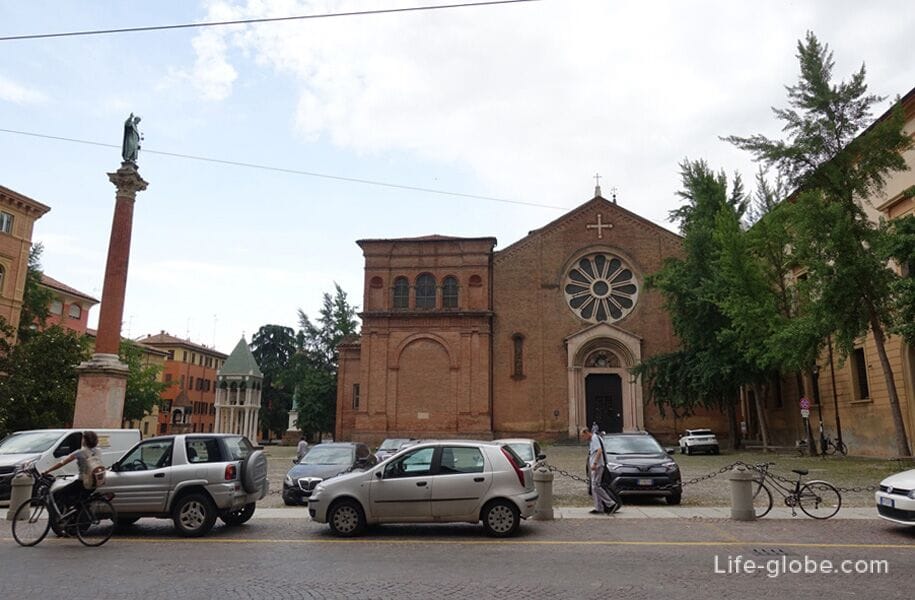
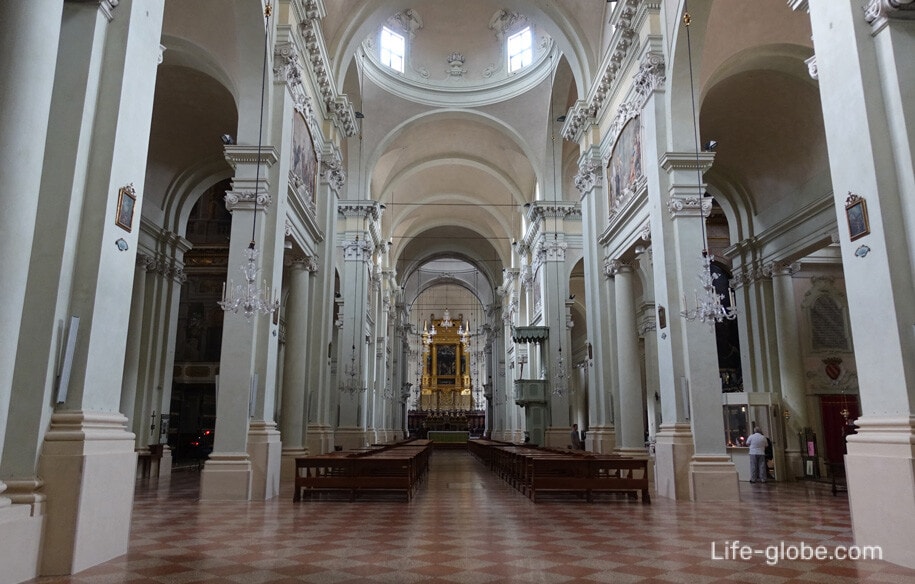
The area that stretches in front of the Basilica of St. Domenica, paved with pebbles, as it was in the middle ages. In the centre of the square stands the brick column, adorned with a bronze statue of St. Dominic (1627).
On the back of the square is the column of "Madonna of the rosary", made of marble, bricks and copper project by Guido Reni (1632), tomb Rolandino de Passeggeri and the tomb of Egidio Foscarini. Read more about Basilica of San Domenico in Bologna...
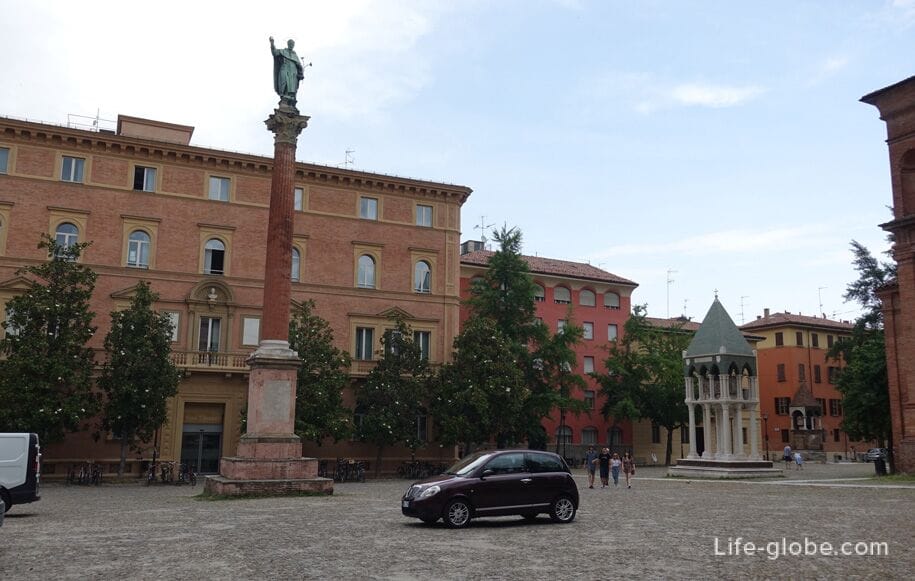

Piazza Cavour, the center of which is a small public garden, built in the second half of the nineteenth century by the demolition of some buildings of the sixteenth century, replaced by other buildings with porticoes that surround the square, including an art gallery.
In 1902 in the center of the garden was a statue dedicated to Benso Camillo di Cavour.

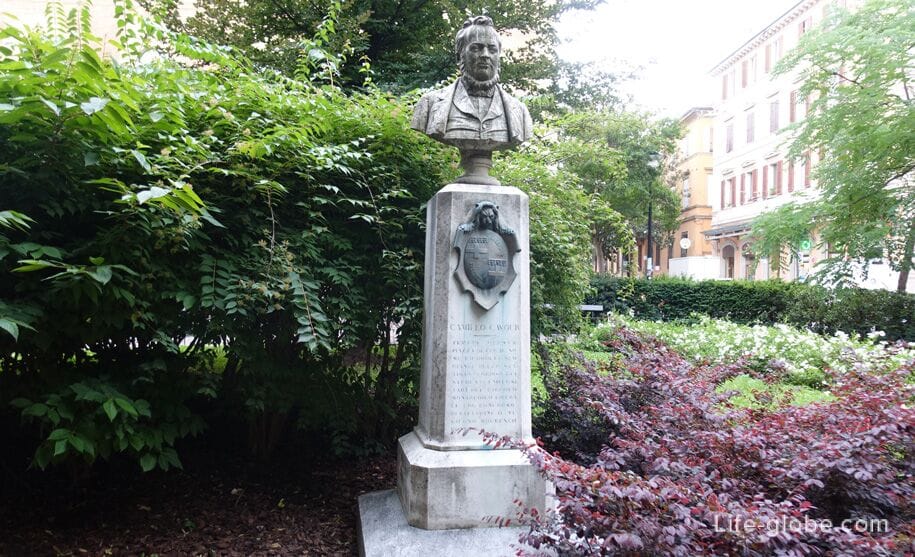
Market delle Erbe (Mercato delle Erbe), also known as the Bologna herbal market.
The market building was designed in 1910 by Arturo Carpi and Luigi's Bellucci to host stalls of merchants who had been taken away from Piazza Maggiore. The building was severely damaged by bombing Second world war and then completely rebuilt in 1949.
In 2014, after the restructuring of some parts of the market, the structure of the active restaurants, bars and pizzerias.

On the market are mainly fresh vegetables and fruits, there are also greens, sausages and meat products, cheeses, fish, olives, etc. read More about the market del Erbe in Bologna...
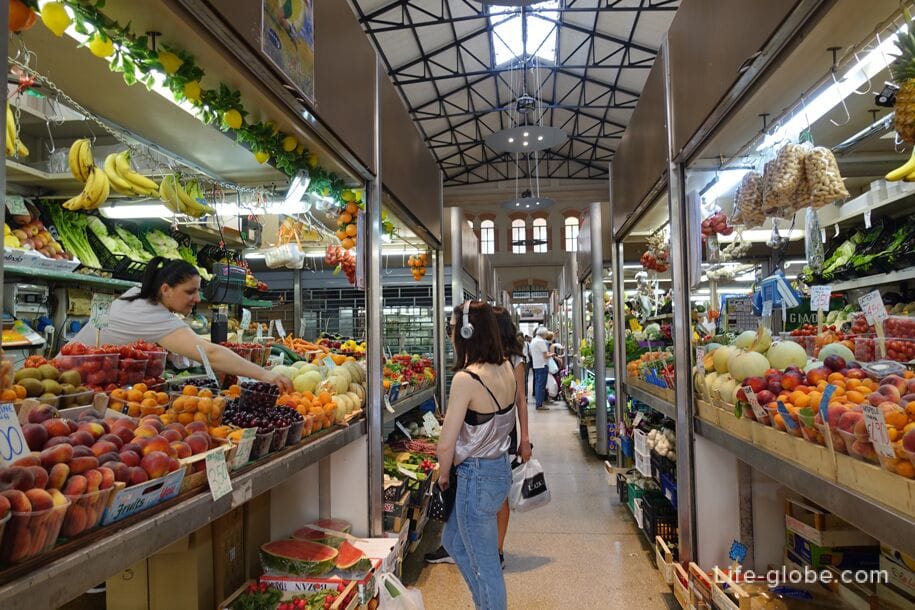
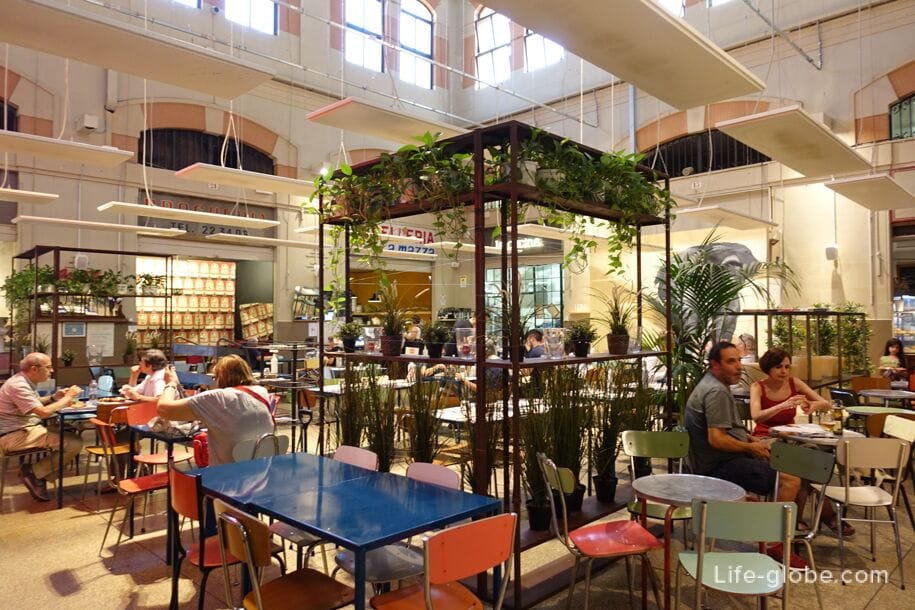
Near the market is the monument of Ugo Bassi (Monument to Ugo Bassi). Bronze statue made by the sculptor Carlo Parmeggiani in 1888. On 8 August of the same year the Committee for creation of the statues, transferred the work of the mayor Gaetano Tacconi. The statue was placed in the middle of Independence street, opposite the theatre "arena del sole".
In 1900 the monument was placed on the street Ugo Bassi. After the bombing of the Second world war the statue was moved to the garden square on September 20. In 2003, after the restoration, the monument has again found its place on the street dedicated to the priest and patriot Giuseppe Bassi.

The Church of Saints George and Shiro (Chiesa Santi Gregorio e Siro), built in the years 1532-1535. In 1780, after the devastating earthquake, Angelo Venturoli restored the Shrine.
On the facade of the building depicts the emblem of the family Ghisilieri that lived on this place until 1445, until he was expelled from the city. The bell tower of the Church is nothing other, as the family tower of the thirteenth century, reduced for use later in 1532.
Modest in appearance, the Church has many works of art inside, among which are some masterpieces Camillo by procaccini, Lucio Massari, Calvert, Calvi, and Carracci.
In the Church is buried one of the outstanding personalities of Bologna physicist and biologist Marcello Malpighi.
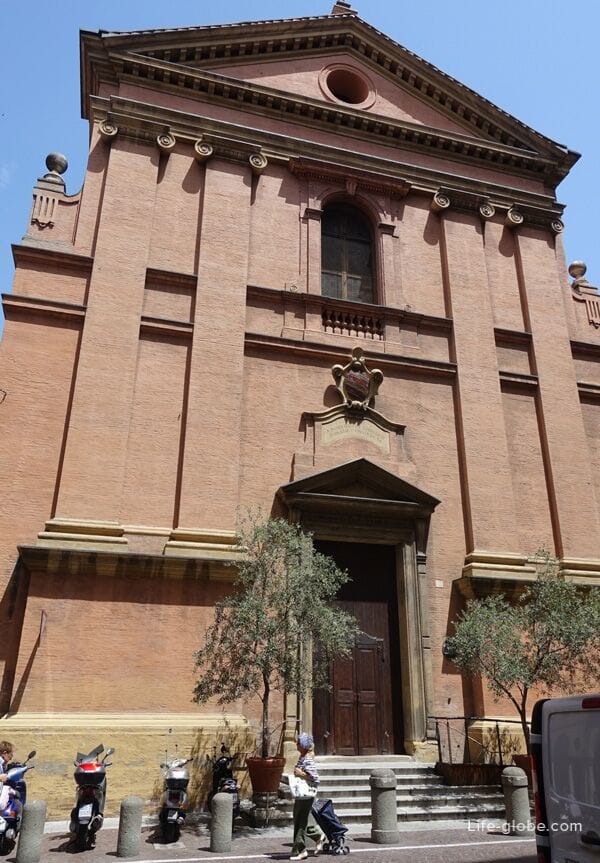
The oratory of the Madonna of San Colombano (Oratory of San Colombano), also known as the former Church di San Colombano and Santa Maria Dell is Orazione (Dame), a religious place in Bologna.
The building was built in 1591 on the site of the chapel, in which was a painting of the Madonna del Oration the work of Lippo di Dalmasio. The Church is called San Colombano to this place was founded in the 7th century by Peter the great, Bishop of Bologna and a disciple of the Irish monk Columban.
Today San Colombano is designed to house the collection of ancient musical instruments and music library.
The cycle of frescoes stretches in a series about the outer arched openings.
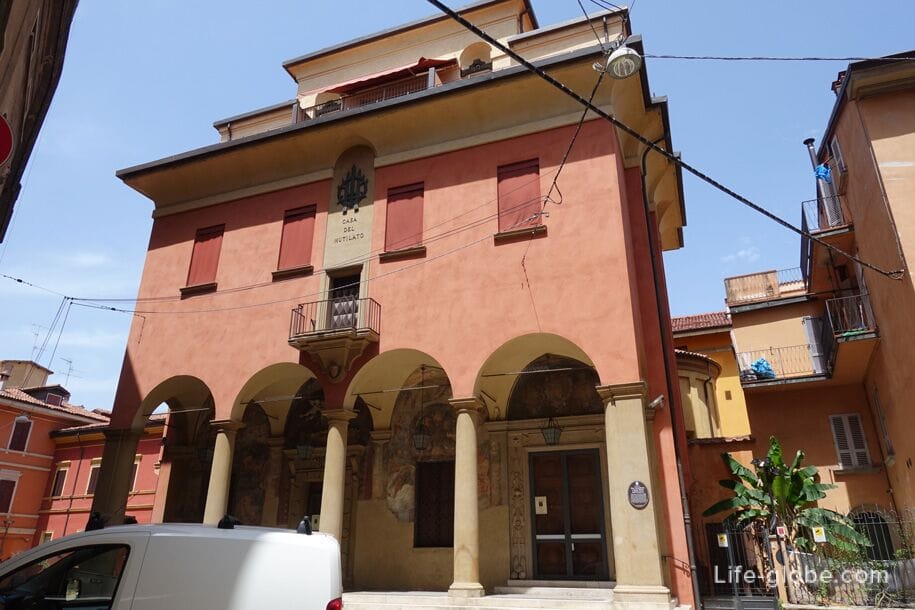
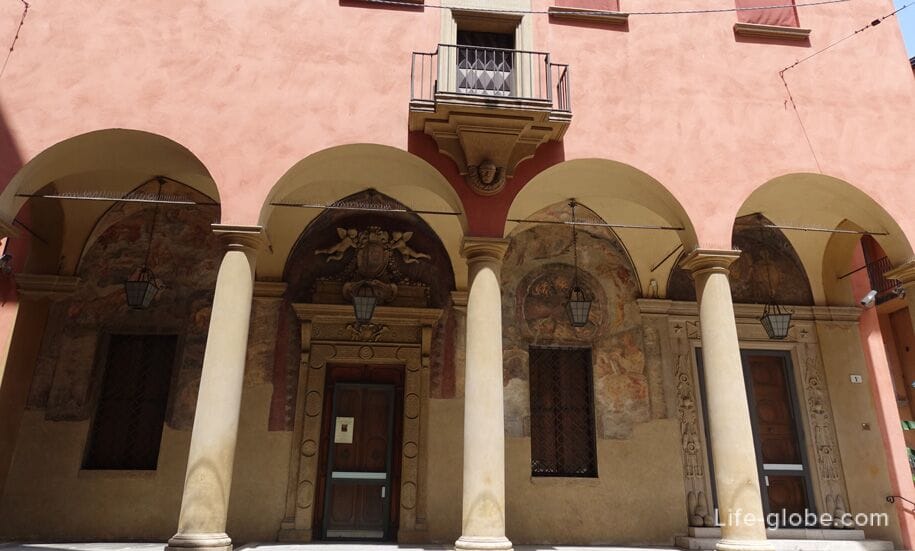
Building San Colombano attached to a number of religious buildings, grouped around each other for centuries and today, with bright facades.
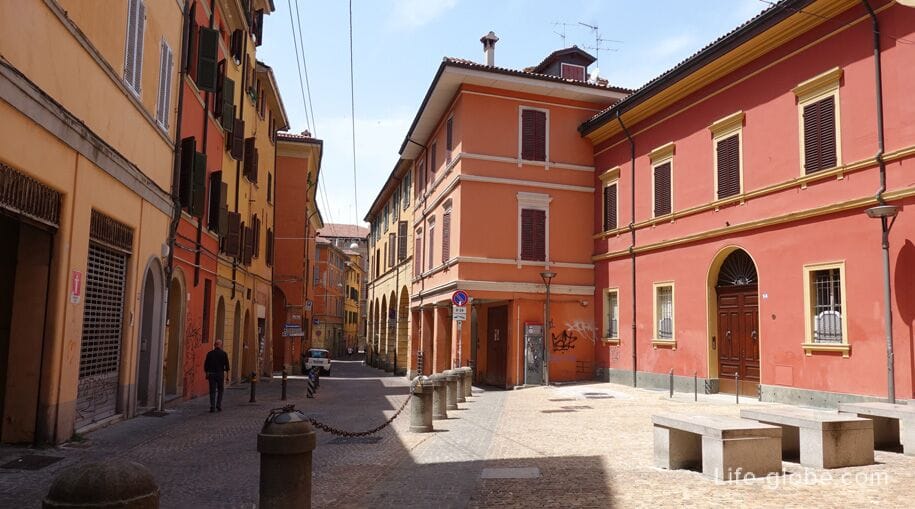
San Giorgio in Podhale - a former Roman Catholic Church in the Baroque style, which serves as a library of art and history.
Legacy library consists of ancient books, modern books (since 1831-present), manuscripts, incunabula, announcements, decrees, notifications, works related to music, as well as archives of Newspapers and photographs.
The Church at this place was present from the time of the Lombardy region, but the present building was designed by the architect Tommaso Martelli and built between 1589 and 1633 years. The first custodians of the Church were the priests of the order of Servico.
In 1798, the Church and the adjacent monastery were suppressed by the Napoleonic government. The bell tower was built between 1760 and 1763 years. With the restoration of the Duchy, the Church was transferred to the Franciscans until 1842, and then moved on to the Jesuits in 1882. Was partially destroyed during the aerial bombing on 25 September 1943.
Almost destroyed in the decades following the war, the building was purchased by the Fund office di Risparmio in Bologna, and they ordered a reconstruction of the architect Michele de Lucchi. Modern library was opened in 2009.
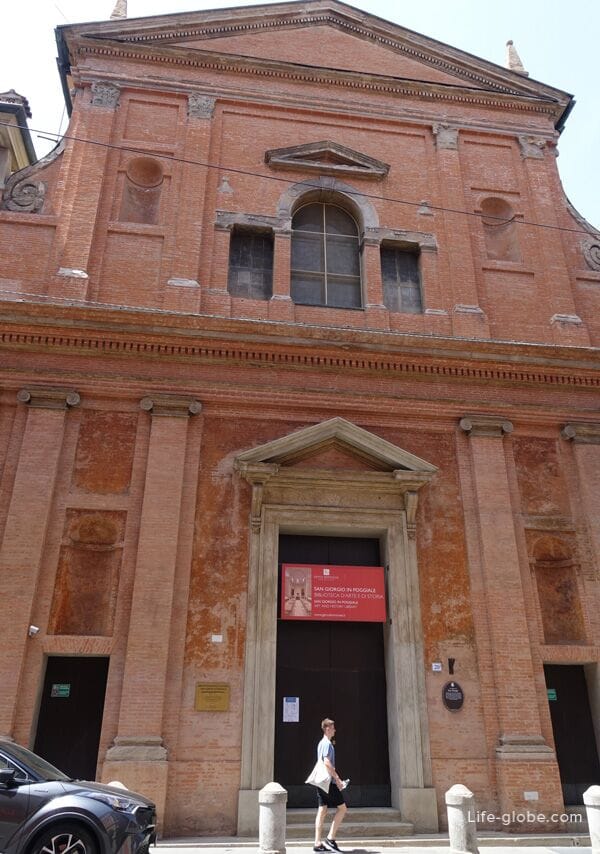
The Basilica of San Francesco or Saint Francis (Basilica di San Francesco) is a historic and one of the largest churches in Bologna, the facade overlooking the homonymous square of Saint Frances (Piazza San Francesco).
Built by the Franciscan community between 1236 and 1254 years, the basic structure of the Basilica was finally completed in 1263, is the first Italian example of Gothic style of French origin.
Currently, the Church is a sort of mix of different styles including Romanesque, Gothic and early Renaissance.
High Roman-Gothic façade has a main portal and is decorated with arched and round Windows.
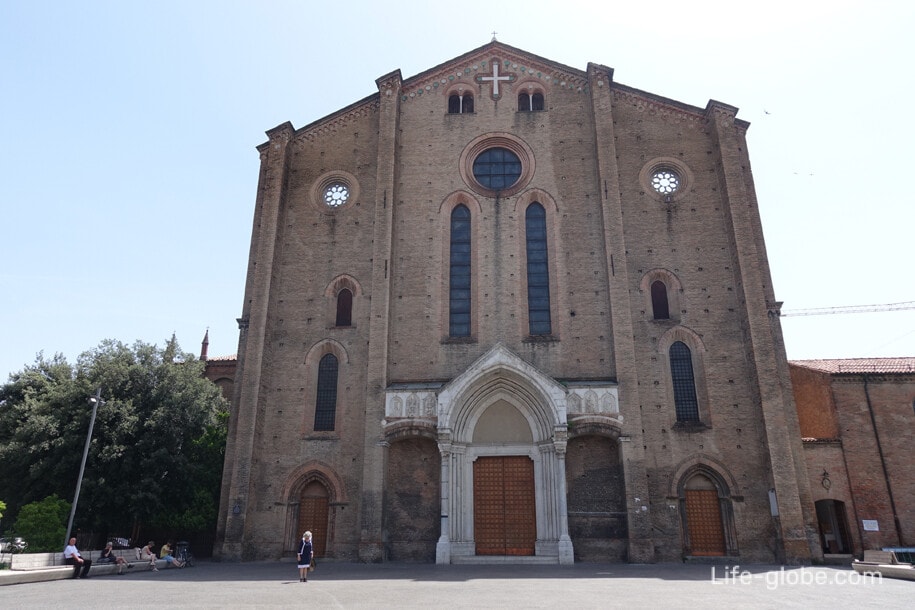
Inside the Church stands a marble altar, surrounded by austere and imposing structure, created in the period between 1388 and 1393 by the Venetians years of Jacobello and pier Paolo Dal Oil.
In addition, there are several distinctive burial monuments such as the grave of Pope Alexander V, designed by Sperandio (1482), the Romanesque chapel of Muzzarelli and monastery of the 14th and 15th centuries (Convento San Francesco Frati Minori Conventuali), which is notable for the courtyard surrounded by a covered gallery where you can organize a flea market. Read more about Basilica of San Francesco in Bologna...
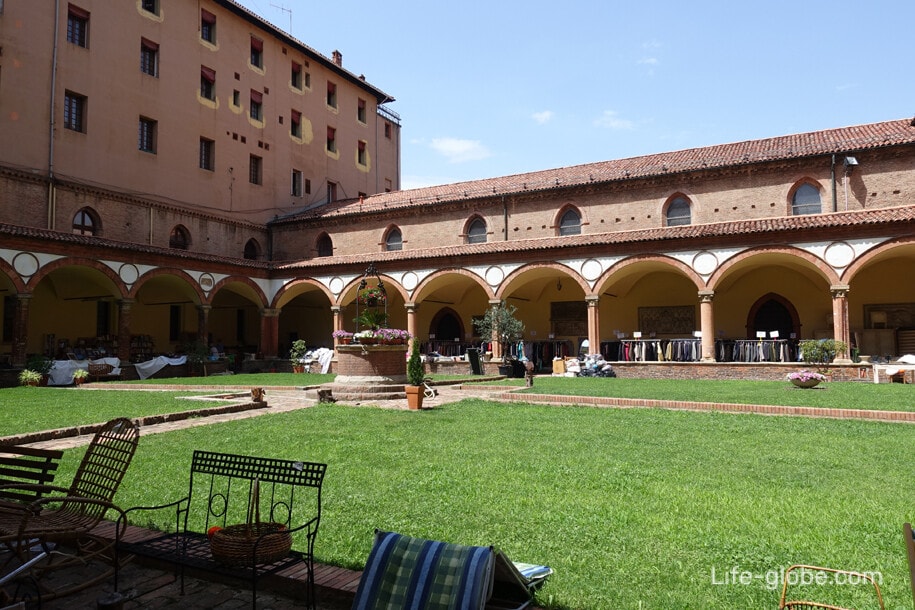
The Basilica, on Malpighi square (Piazza Malpighi), is remarkable for the high column of the Immaculate conception (Colonna Dell'immacolata).
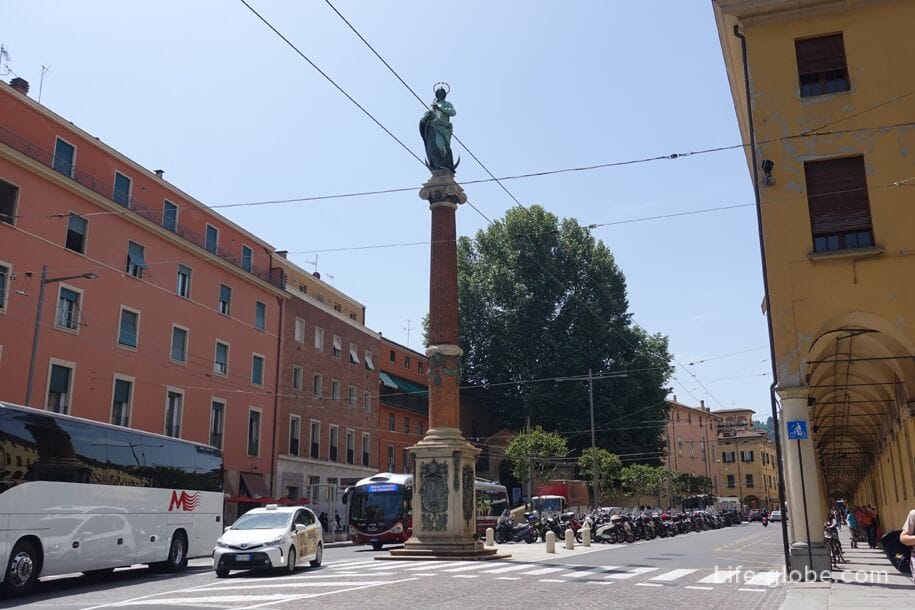
The Church of Santa Maria Visitine or Ponte delle Lame (Santa Maria Delle Visitazione al ponte delle Lame), dedicated to the visit of Mary to Elizabeth, mother of John the Baptist.
The Church was originally built on a bridge across the channel of Reno in 1527, when the image of the Madonna in a tabernacle on the bridge was a place of prayer during the epidemic of plague. After the epidemic receded, the place of the tabernacle was erected the Church of the Visitation, to keep a wonderful look.
The first Church was ruled by a Brotherhood of Devotees, and then, beginning in 1764, the Brotherhood of San Rocco, was reconstructed the interior in the Baroque style. July 16, 1942, the Shrine was declared a Marian Sanctuary.
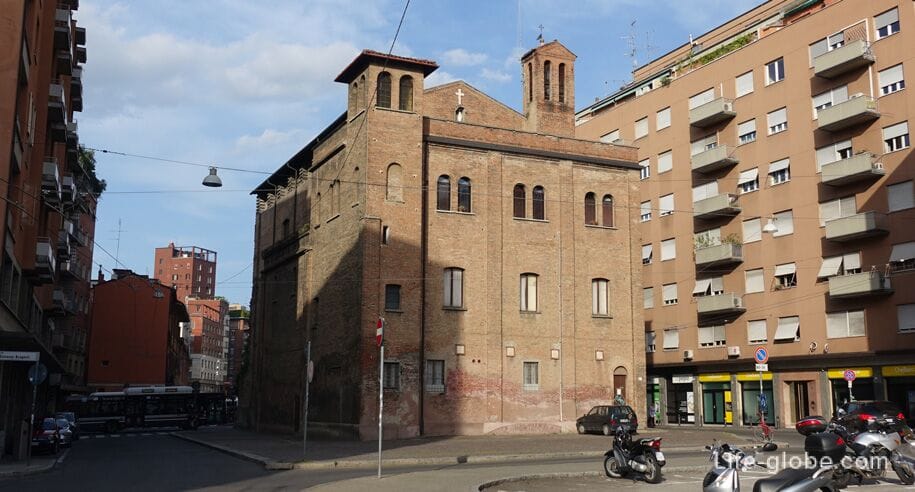
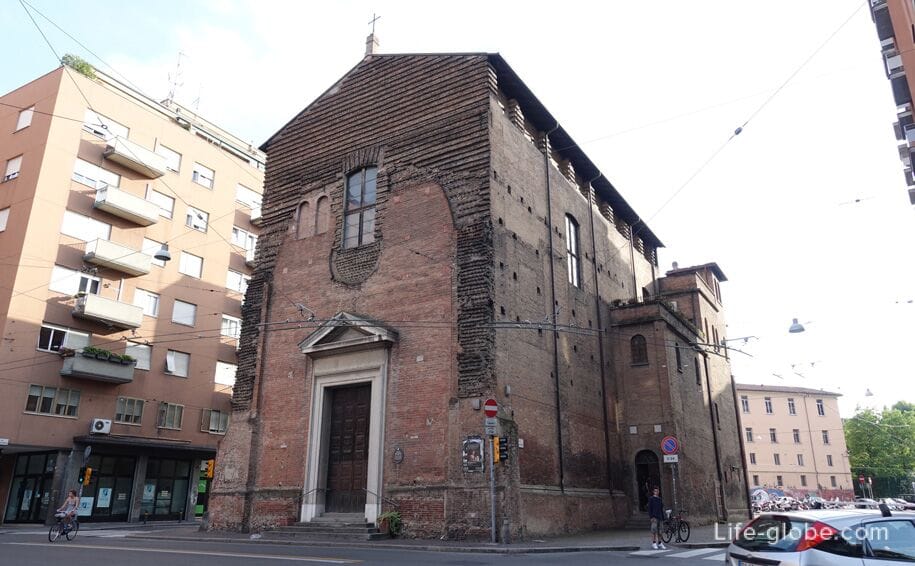
Finestrella or window on the canal delle Moline (Finestrella Canale delle Moline) is a narrow channel, almost hidden from view, because both sides are buildings, standing right next to each other. The balconies of the buildings hang directly over the waters of the channel. There is also a cafe overlooking the canal.
To see the channel from the streets Piella, Malcontenti, Alessandrini.
This area of the city popularly known as "little Venice".
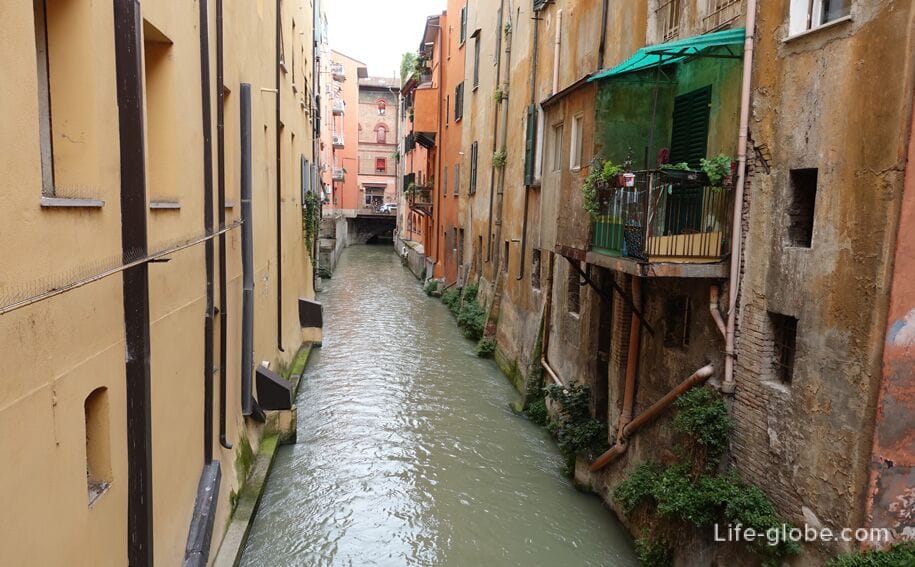
Area VIII Aug (Piazza VIII Agosto). Originating from Roman times, the space currently known as Piazza VIII Agosto, became property of the municipality of Bologna in 1219 and acquired the name of Piazza del Mercato as the space reserved for cattle market since 1251.
After many events, during the Napoleonic period, Piazza del Mercato was renamed Piazza d Armi /square of Arms, as it were exercises and military operations. The name existed before August 8, 1848, when the Bolognese defeated the Austrian troops and called the area the date of victory. In honor of the memory of this event on the square is a monument, the work of Pasquale Rizzoli.
Today the area is home to the historic market "La Piazzola", which every Friday and Saturday quickens as the square and the adjacent Park Montagnola (Parco della Montagnola).
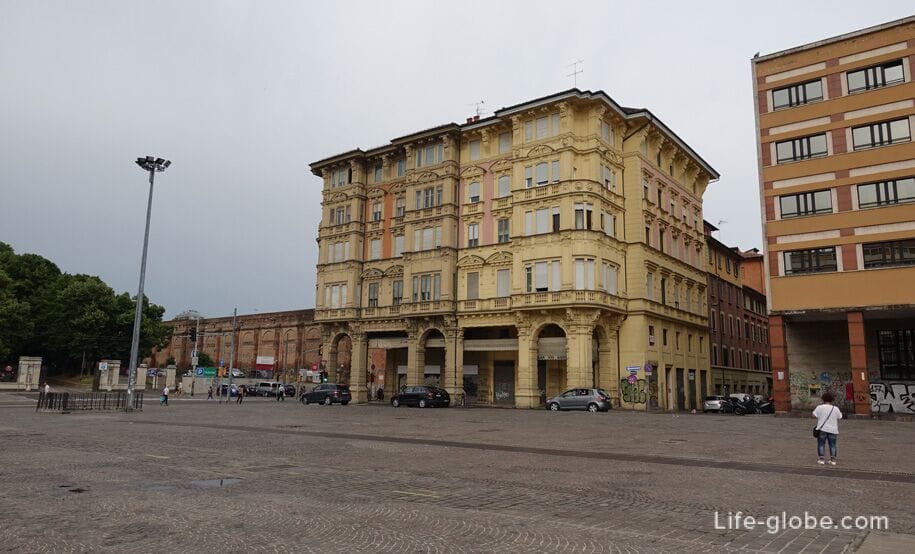
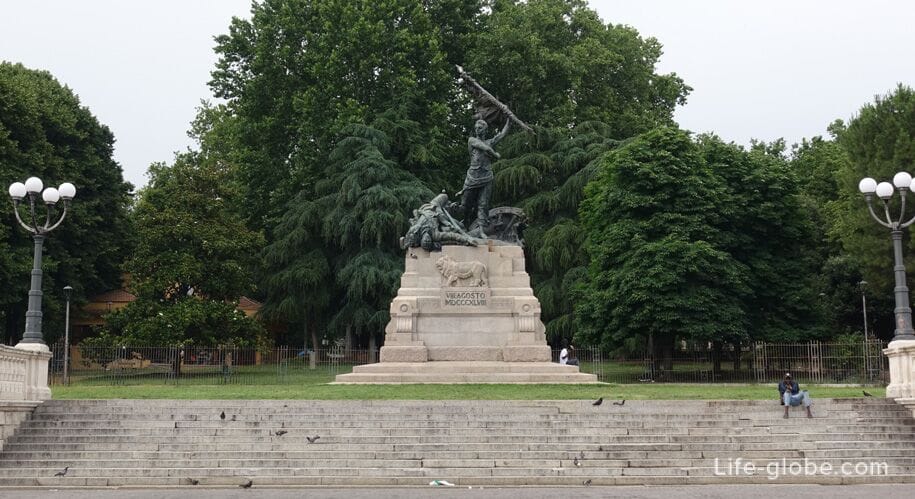
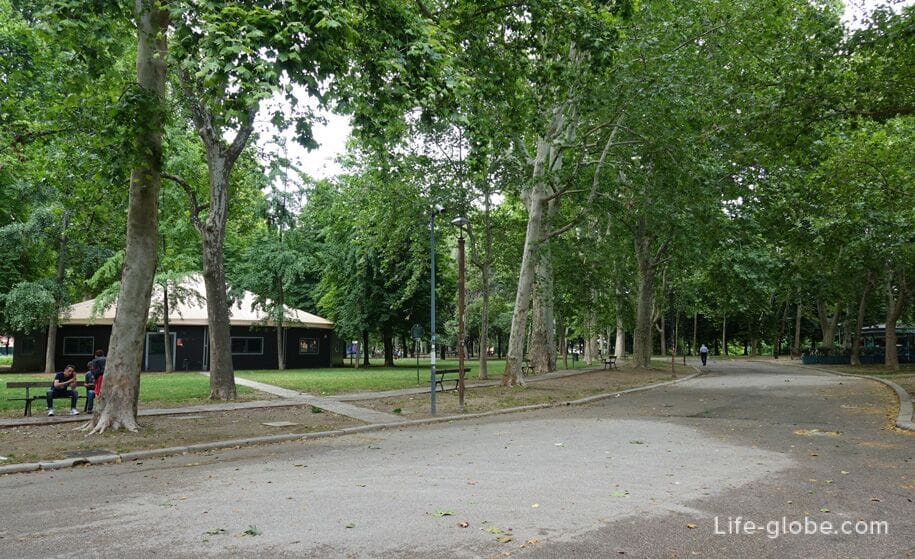
The arena del sole theatre (Teatro Arena del Sole) is one of the most beautiful Italian theatres.
On the neoclassical facade of the building indicate the words "Seat reserved for the daily show."
The present theatre, outdoor 20 February 1995, has two halls: the "Sala Grande" on 888 seats and a smaller hall "Sala Interactive". Also, there is an open space called "Il Chiostro Dell'arena" - yard, received from a former monastery situated in this location before construction of the theater, which now hosts summer performances.
The walls of the theatre, in addition to prose, dance and music, organize business meetings, conferences, seminars and other events.

Opposite the main facade of the theater is the equestrian monument to Giuseppe Garibaldi (Monumento a Giuseppe Garibaldi). The monument was opened on 8 July 1900. Bronze statue located on a pedestal, which was formerly a statue of Ugo Bassi.
Behind the monument is a 4-star Zanhotel Tre Vecchi with Breakfast buffet.

Beyond the historic gates of Bologna, and also sights of interest, which include:
The sanctuary of the Madonna di San Luca (Santuario Madonna di San Luca) is a monumental Church dedicated to the virgin Mary, is located on Guard hill (Colle della Guardia) South-West of Bologna's historic centre.
To the Church leads to the Portico di San Luca, perhaps the longest in the world connecting Port Saragossa with the temple.
Currently, the Church of San Luca, is a revered Shrine, one of the symbols of Bologna which are among the main attractions of the city and the surrounding and a place of pilgrimage and the veneration of the icon of the Madonna of San Luca. Read more about the sanctuary of the Madonna di San Luca in Bologna...
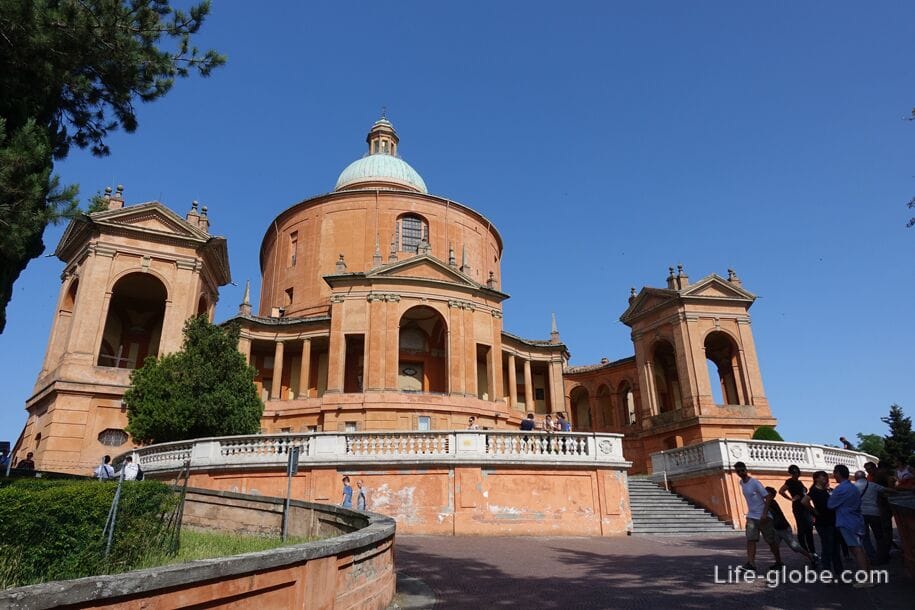

Cemetery of Milan (Cimitero monumentale della Certosa) is a monumental historic cemetery Certosa monastery, one of the oldest in Europe.
The necropolis was founded in 1801 by reusing pre-existing structures of the monastery, founded in the mid-fourteenth century, which preserved the Church of San Girolamo.
Passion of the nobility and the bourgeoisie of that time to build a family tomb turned Certosa in a real "open air Museum" is a unique place sculpture and architecture in the nineteenth and twentieth centuries.
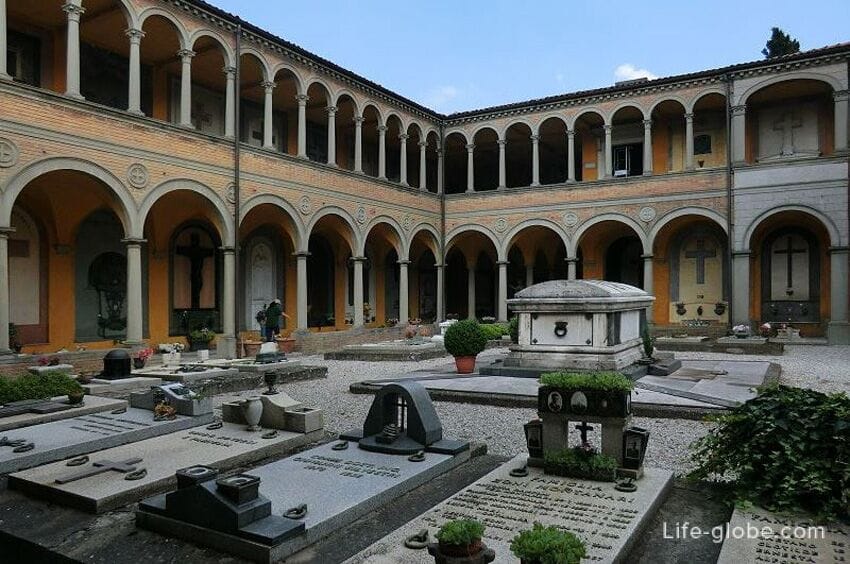
Park the Giardini Margherita and the gardens of Marguerite (Al Parco Giardini Margherita) is the largest and most visited urban Park based on the example of parks in the major Italian and European cities.
The Park was opened in 1879 under the name Passeggio Regina Margherita (after the wife of Umberto I).
The gardens, covering an area of 26 acres, save a substantial part of the original plan, with lots of greenery, walkways, a pond surrounded by artificial chalk cliffs and extensive lawns.
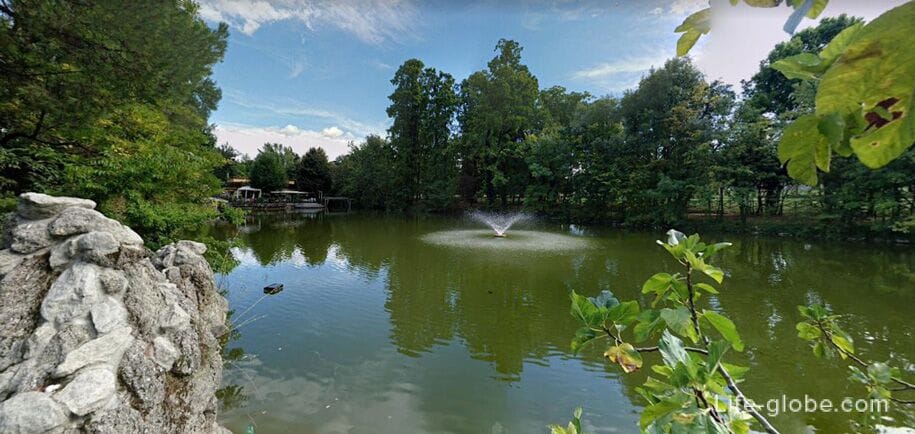
In Bologna, in the heart of the city and beyond, there are many churches, e.g., Church of San Paolo di Ravon (Chiesa San Paolo di Ravone), etc.
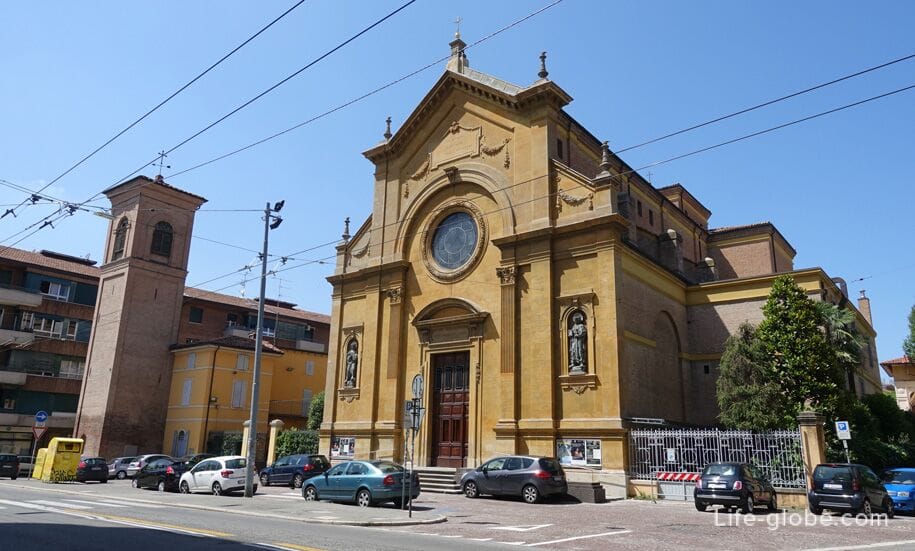


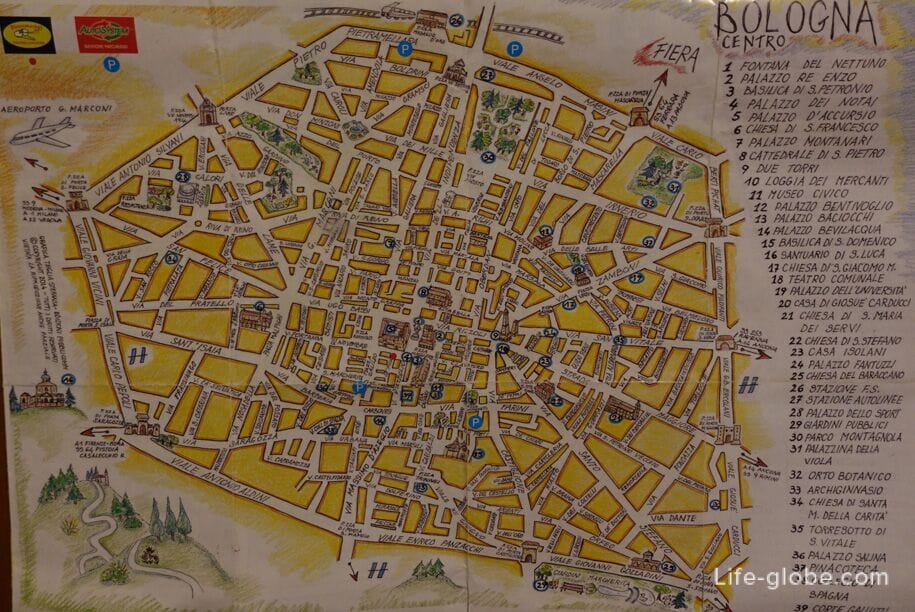
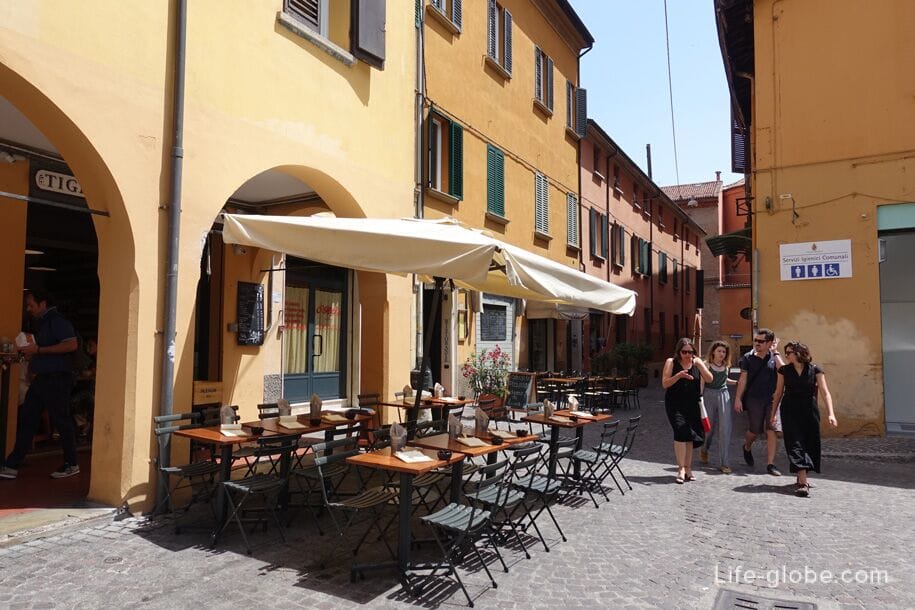

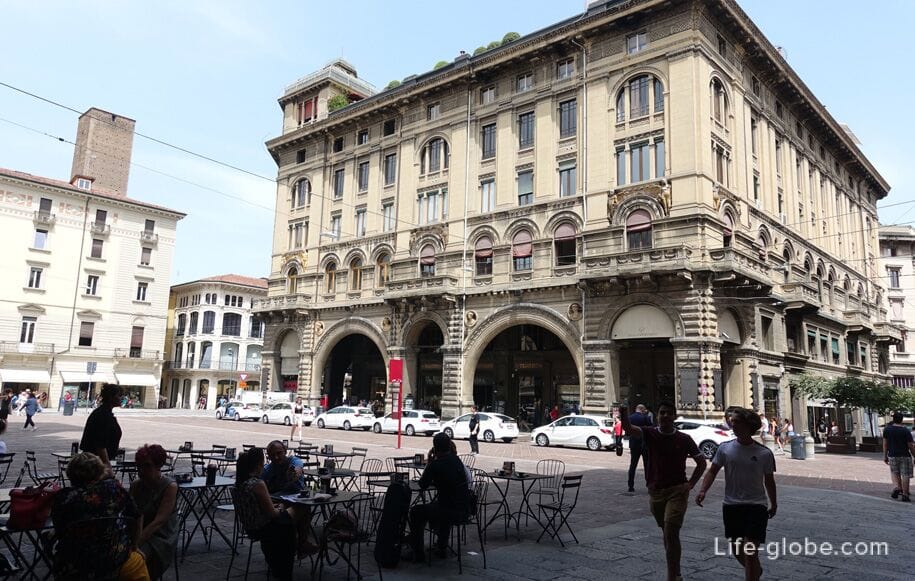
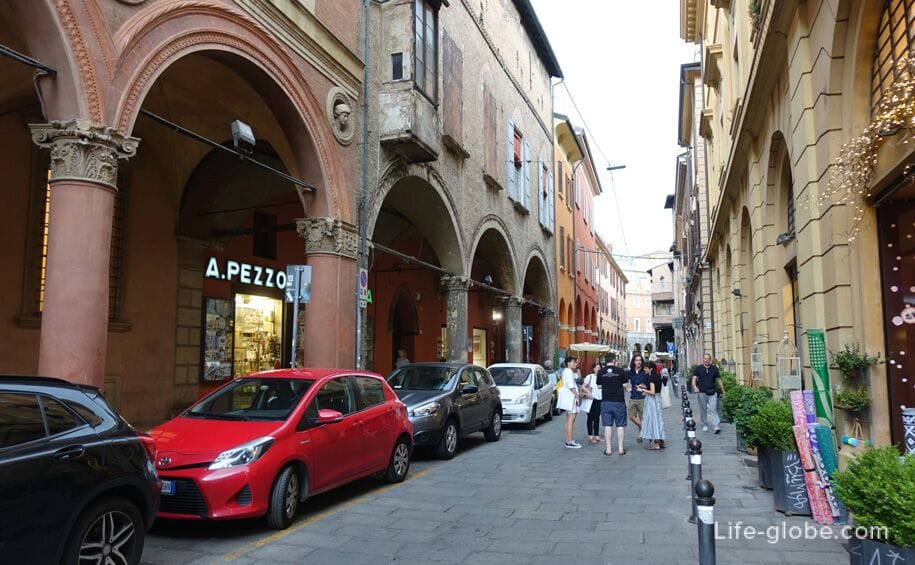

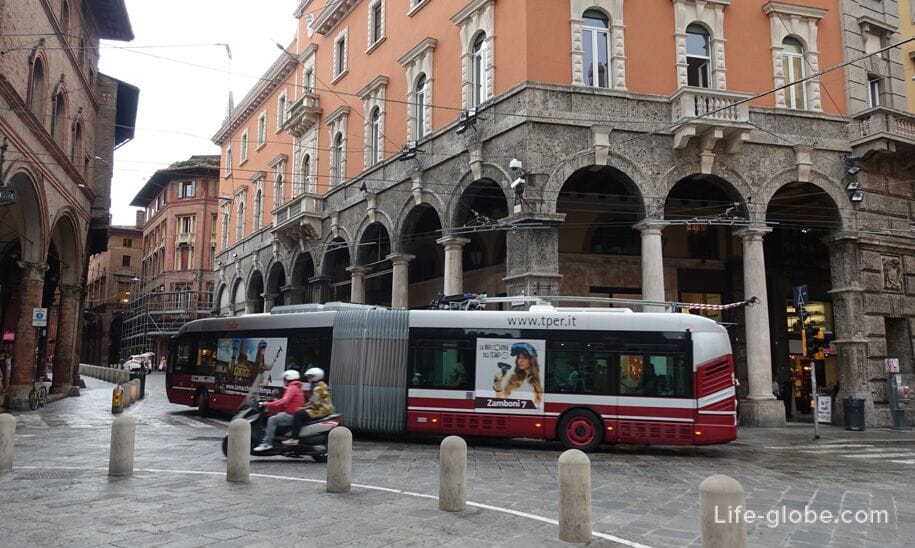

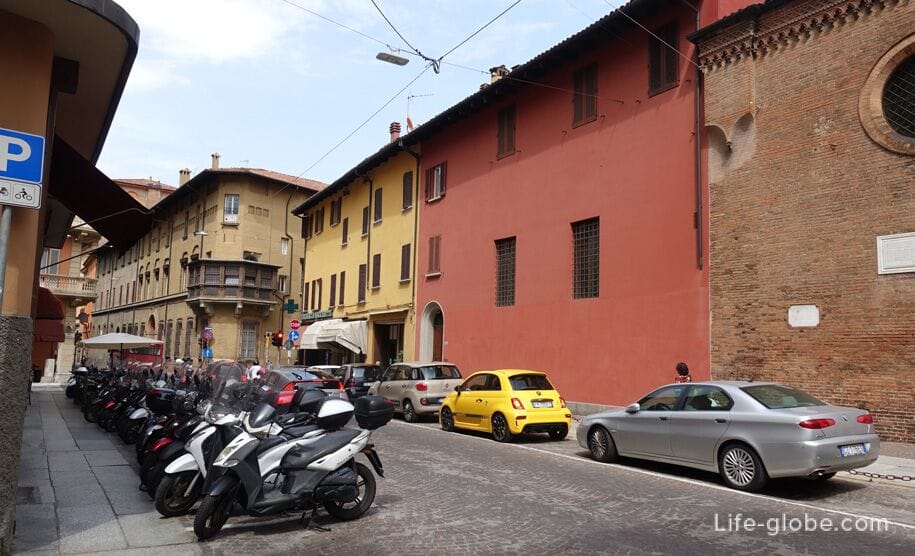

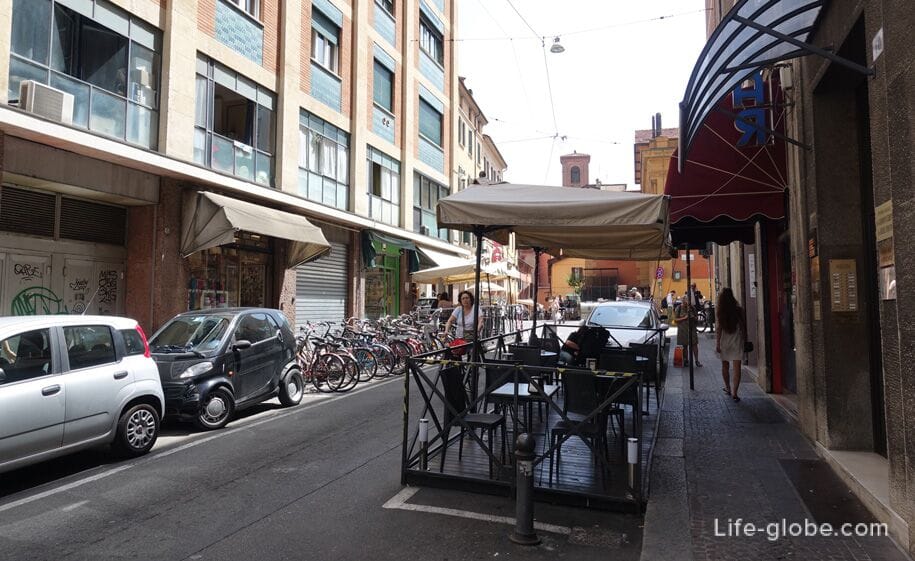
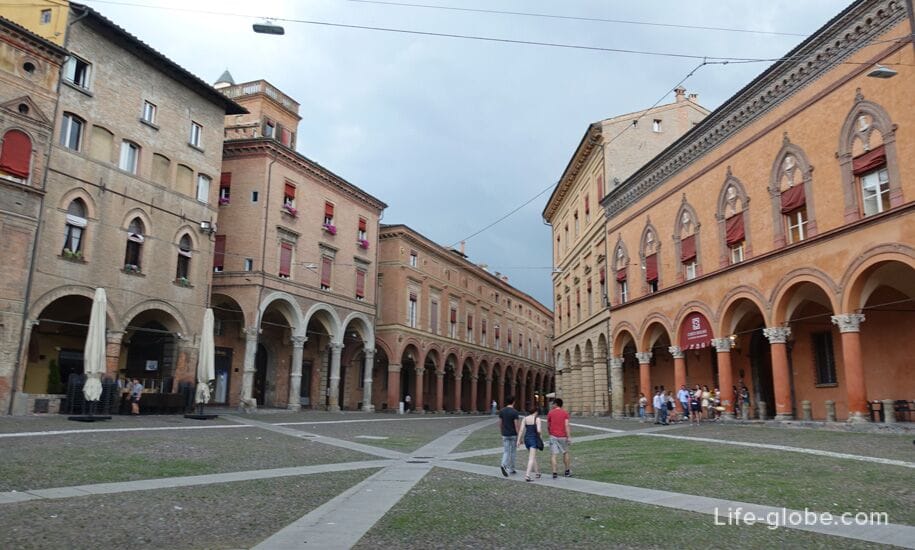
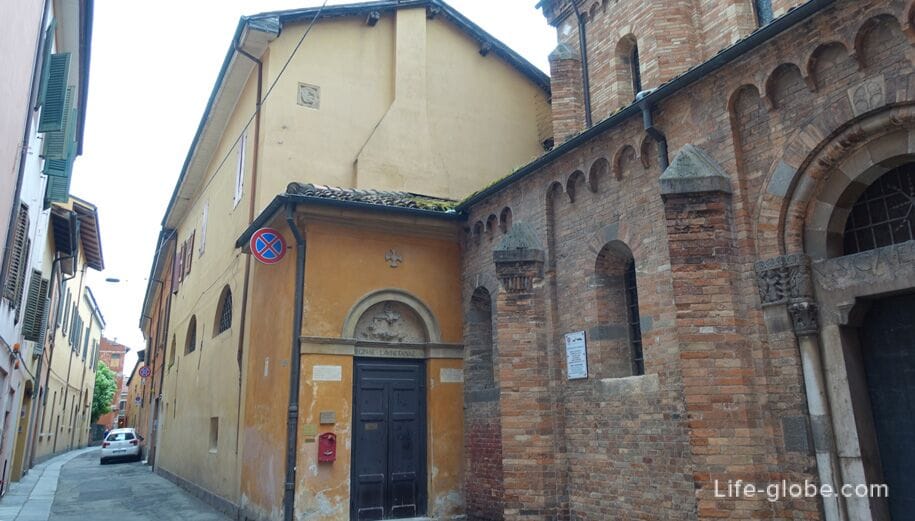

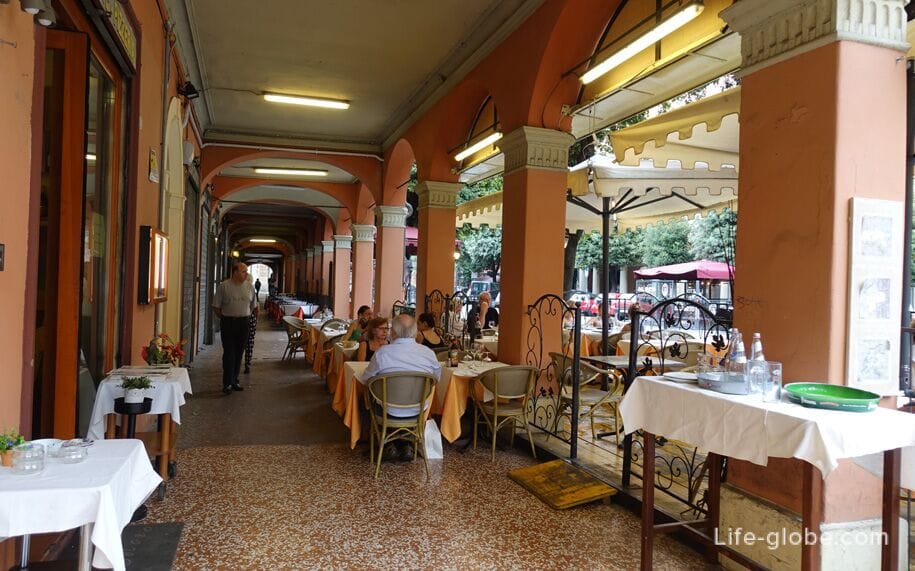
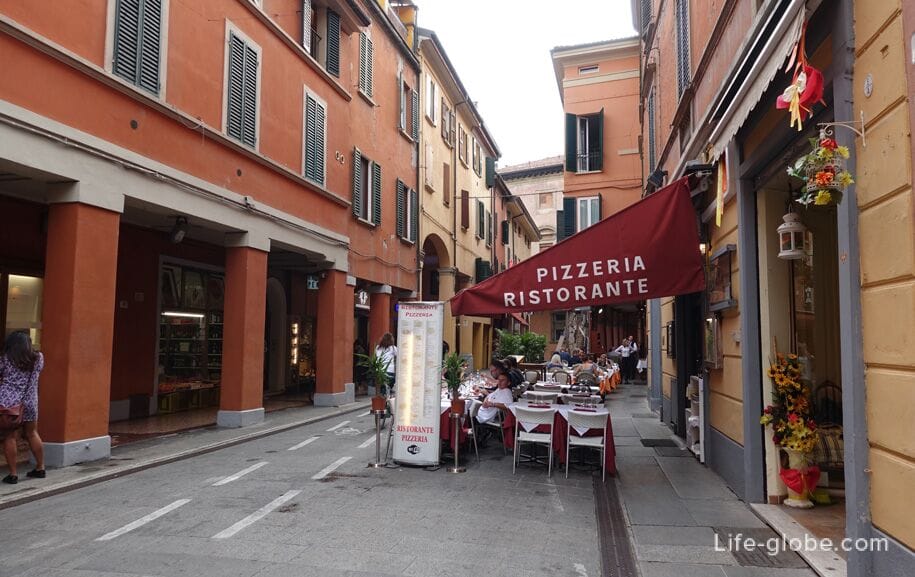
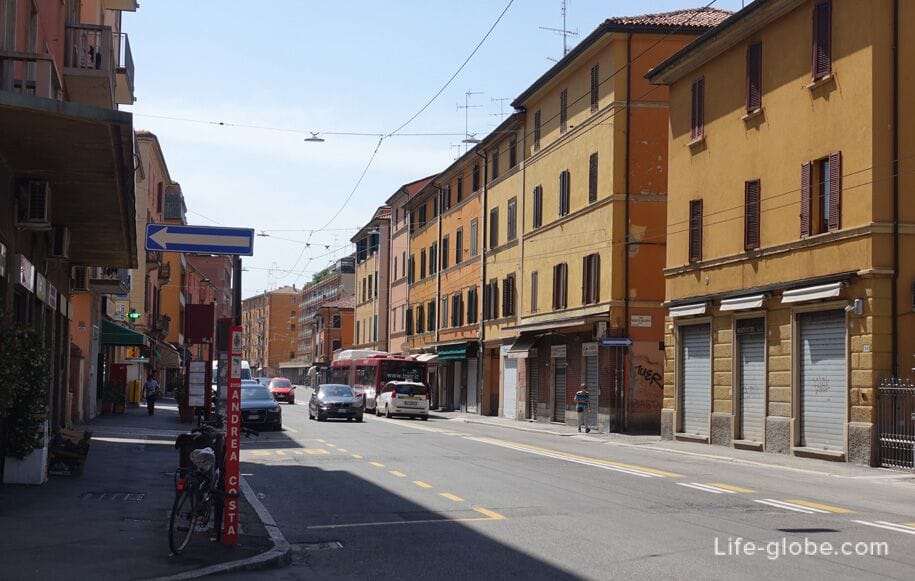
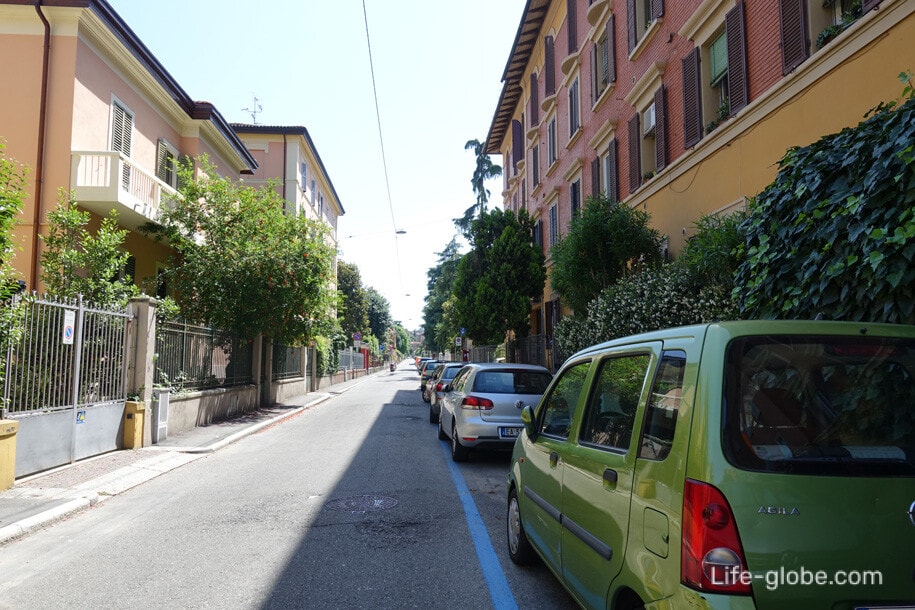
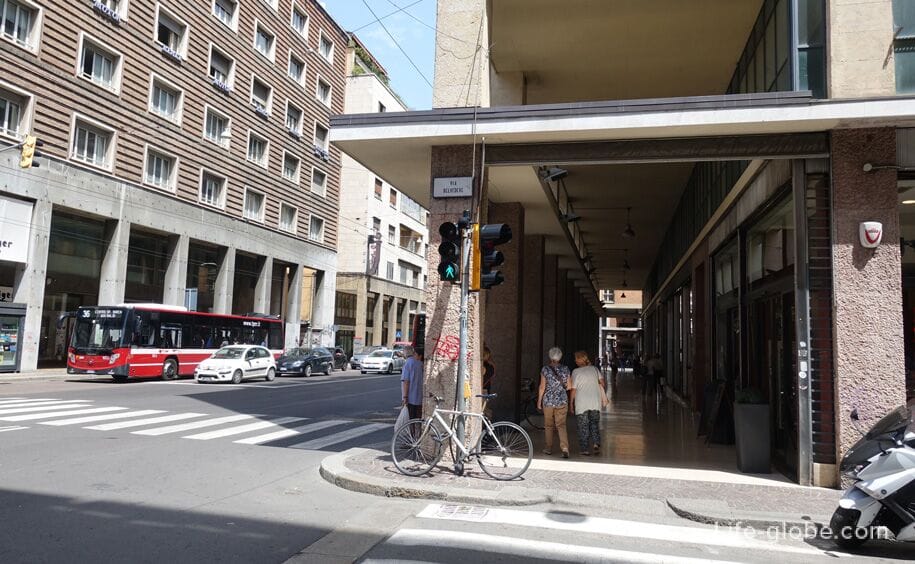
Accommodation facilities (hotels, apartments) in the historical centre of Bologna